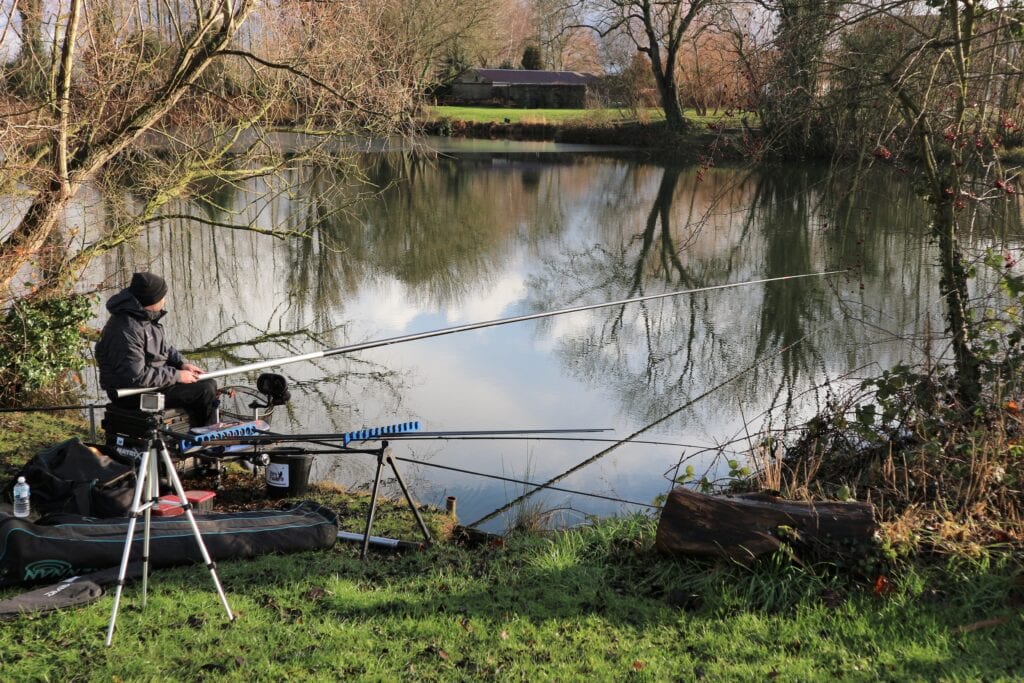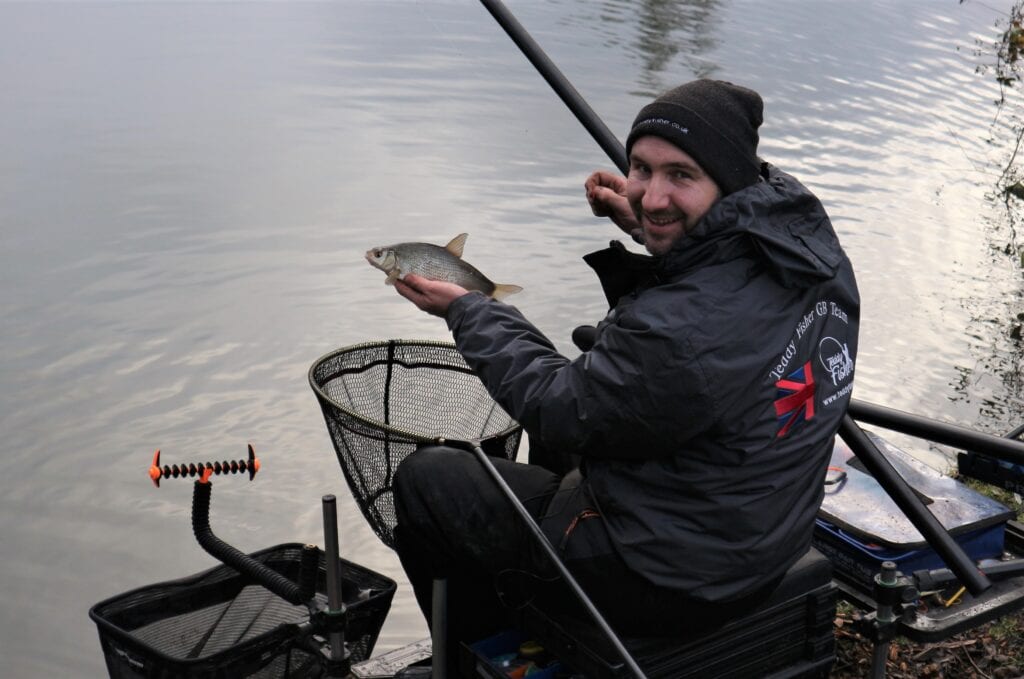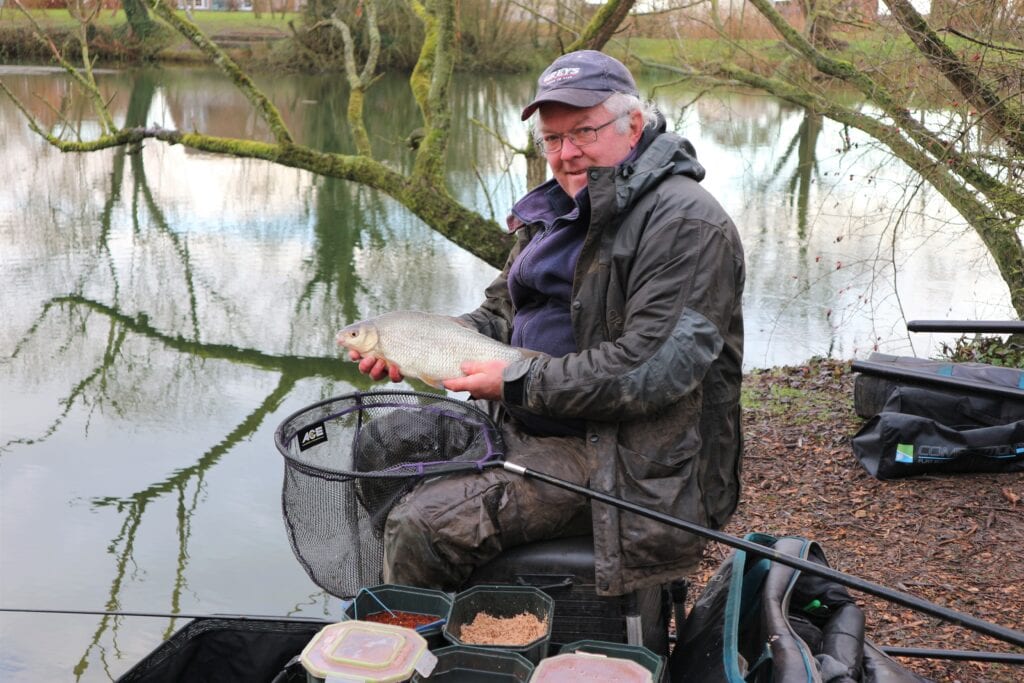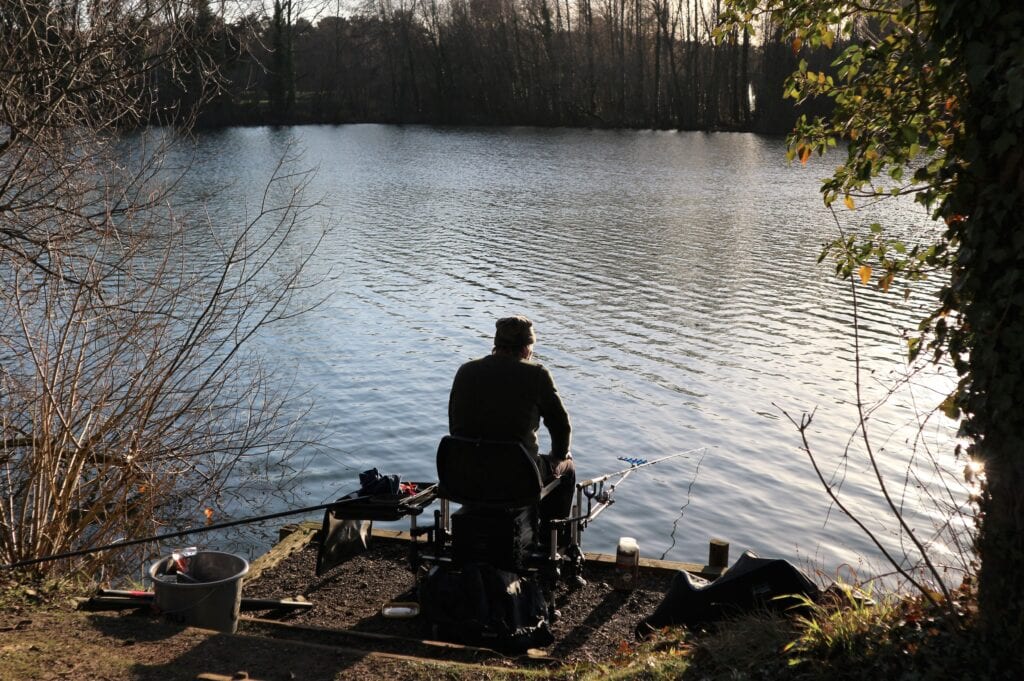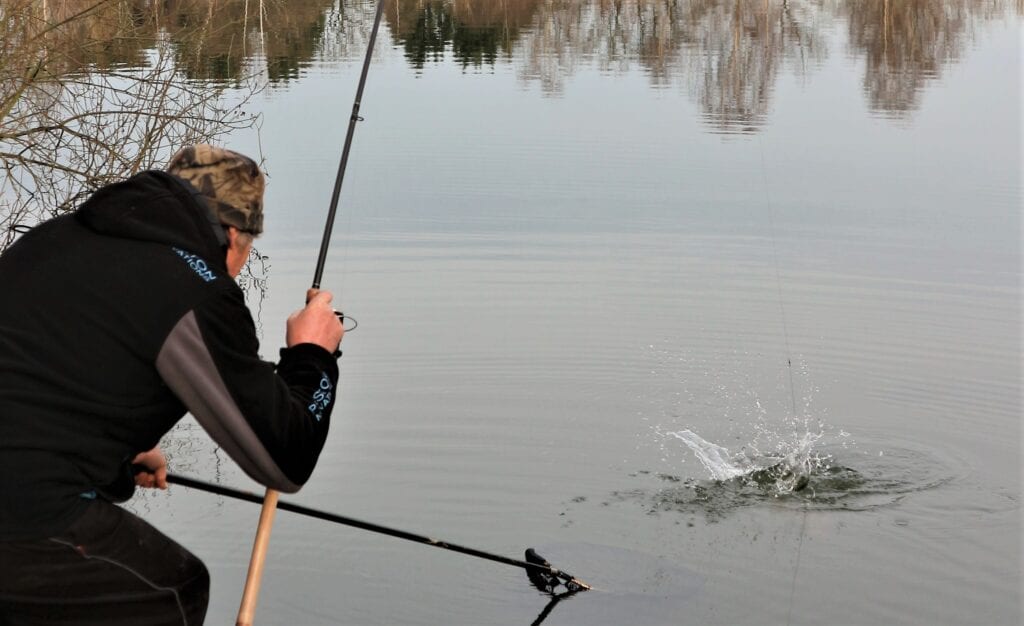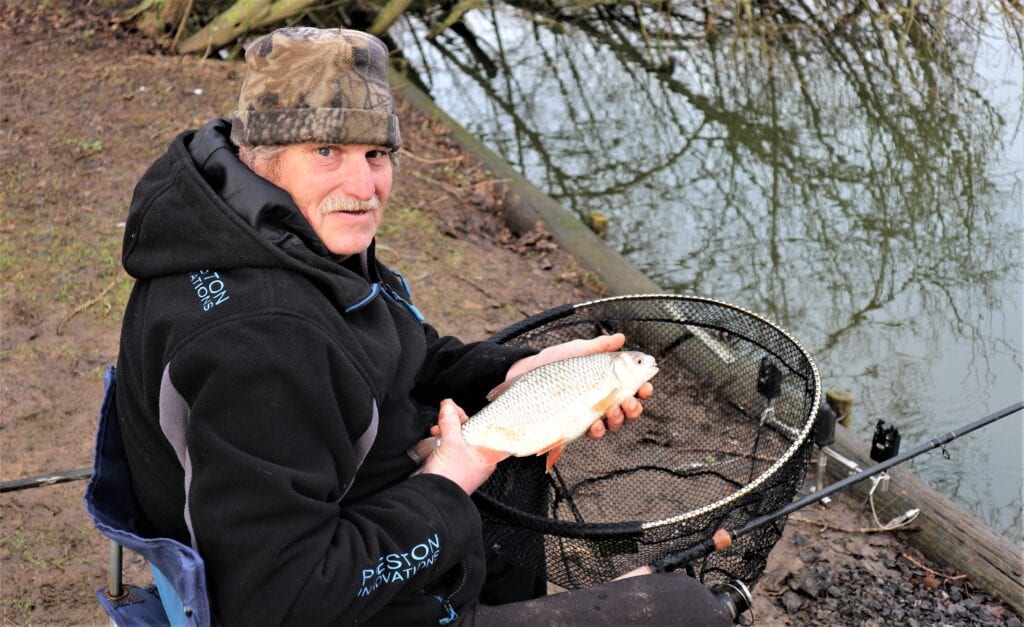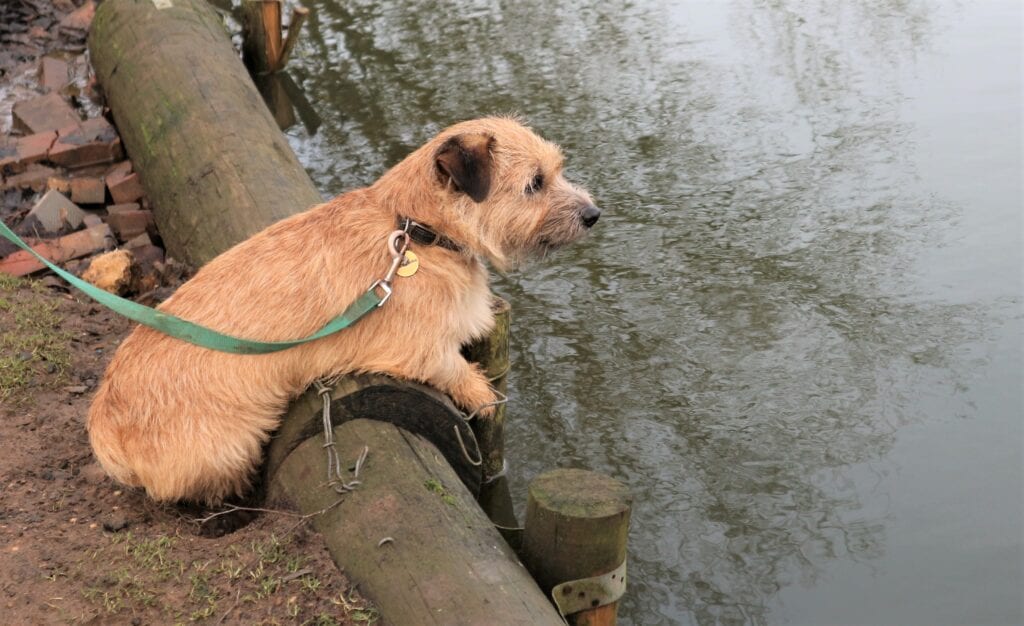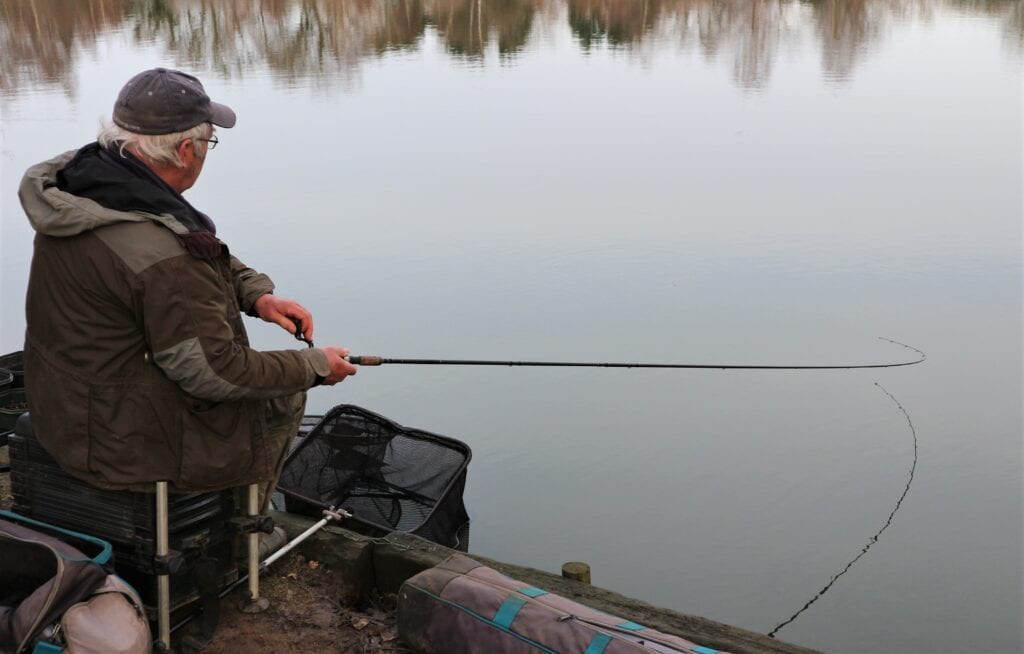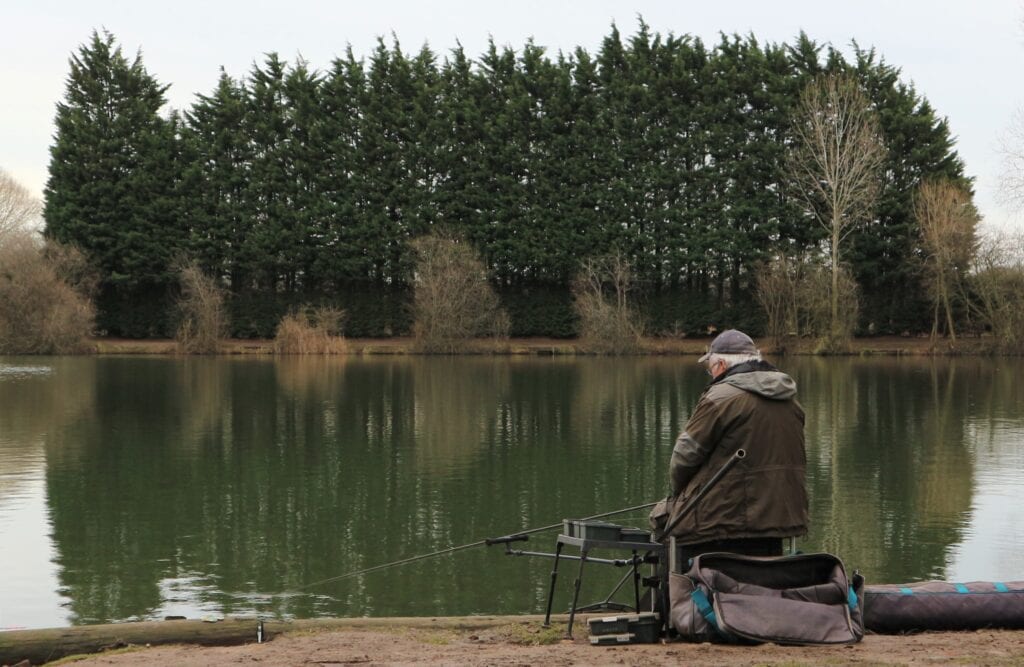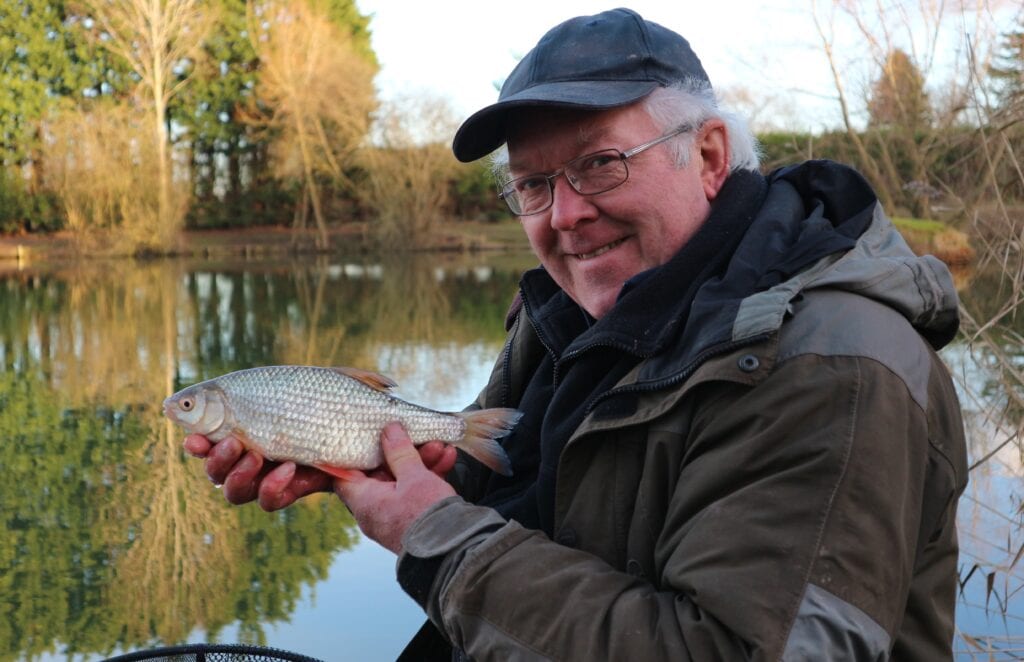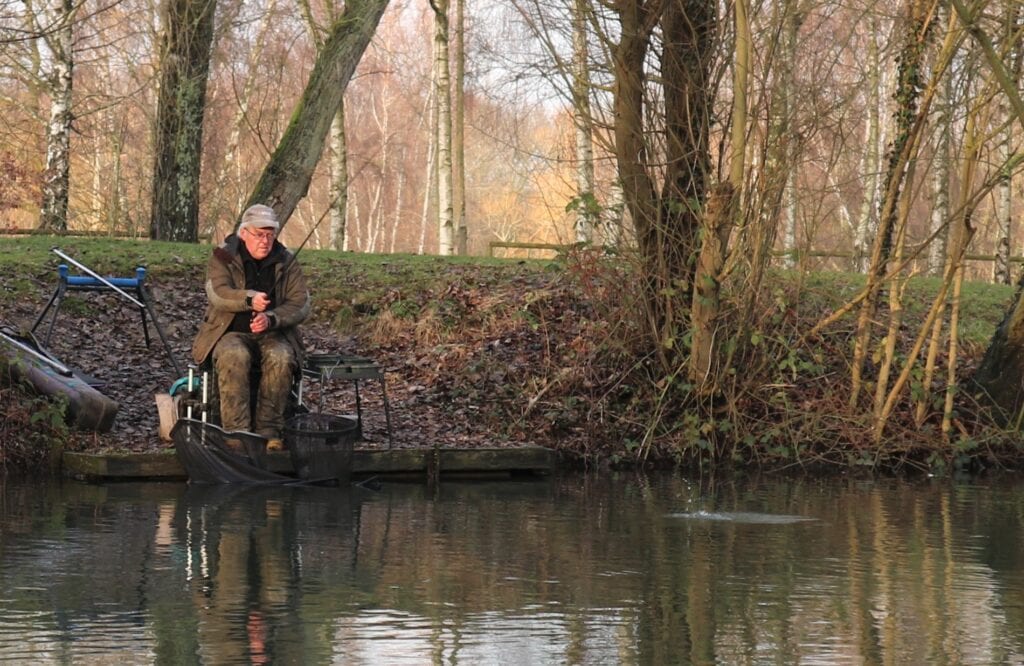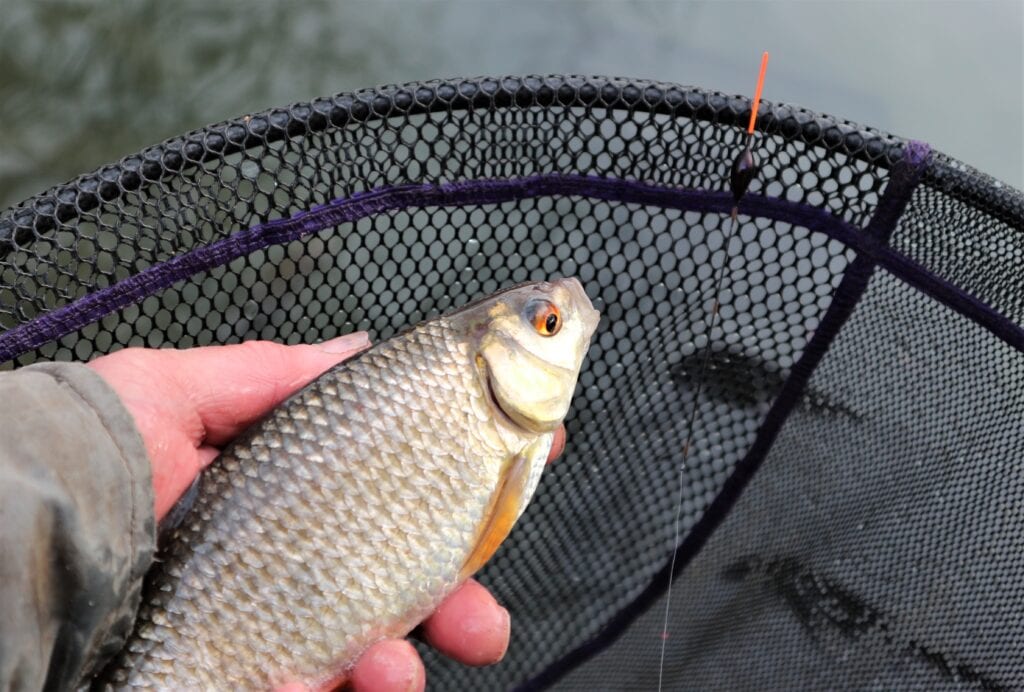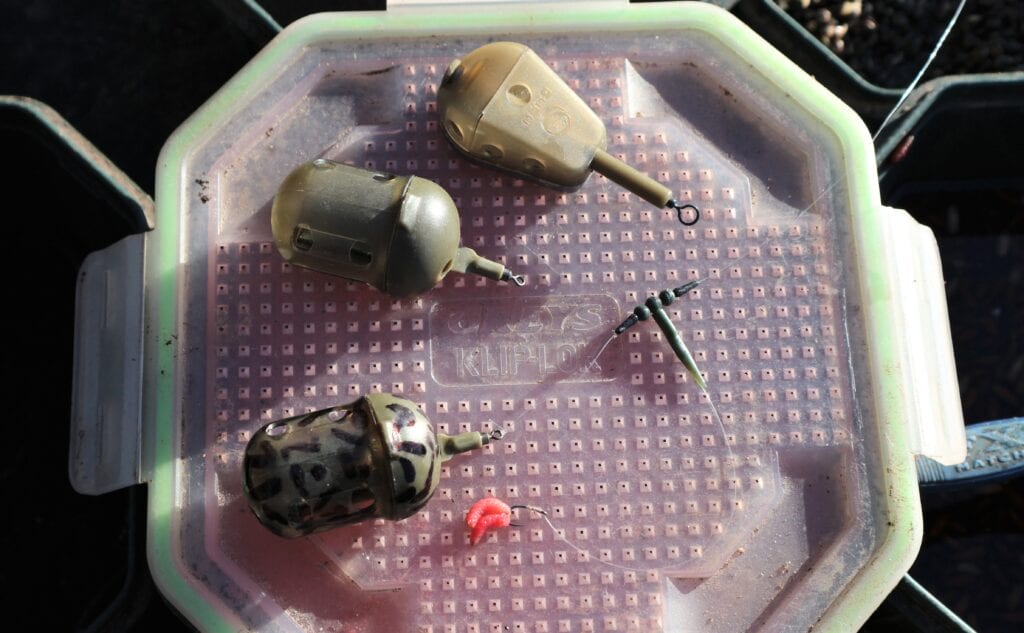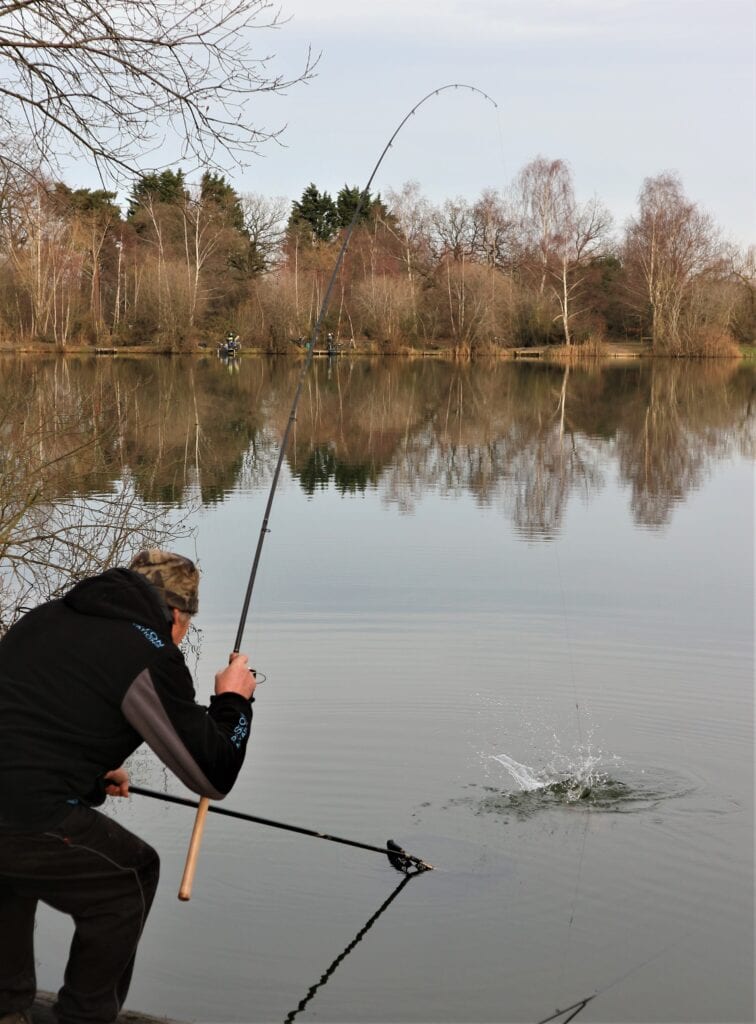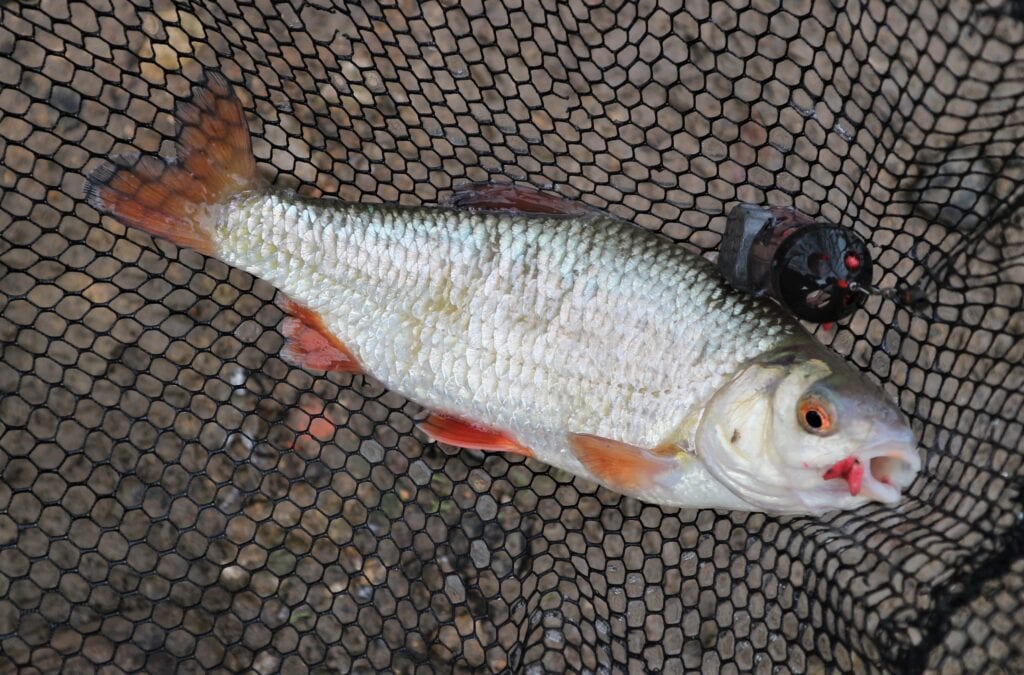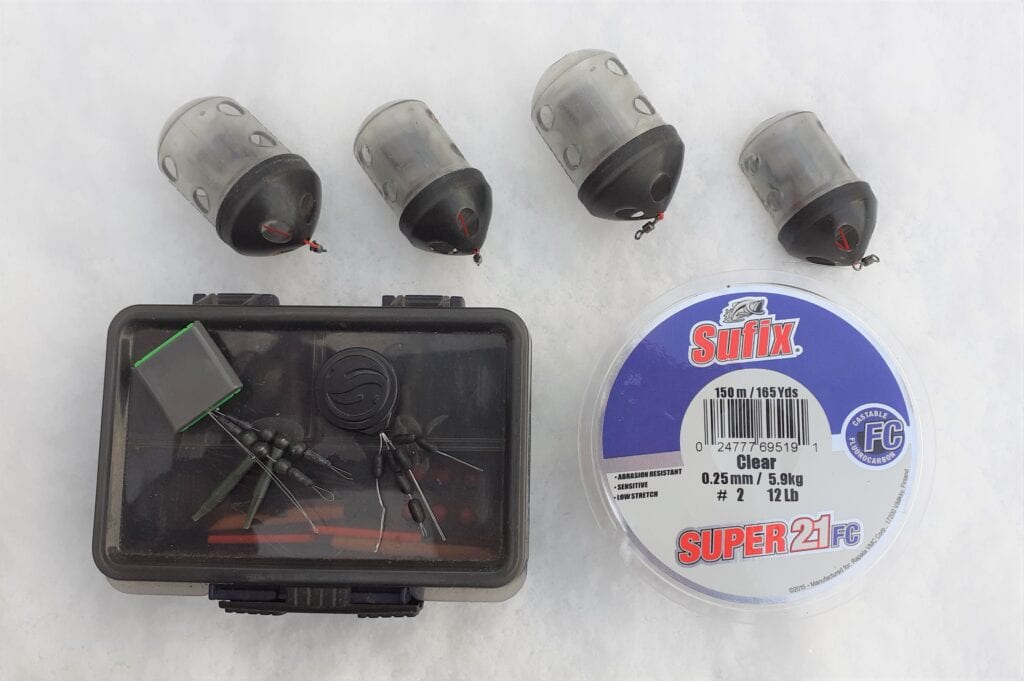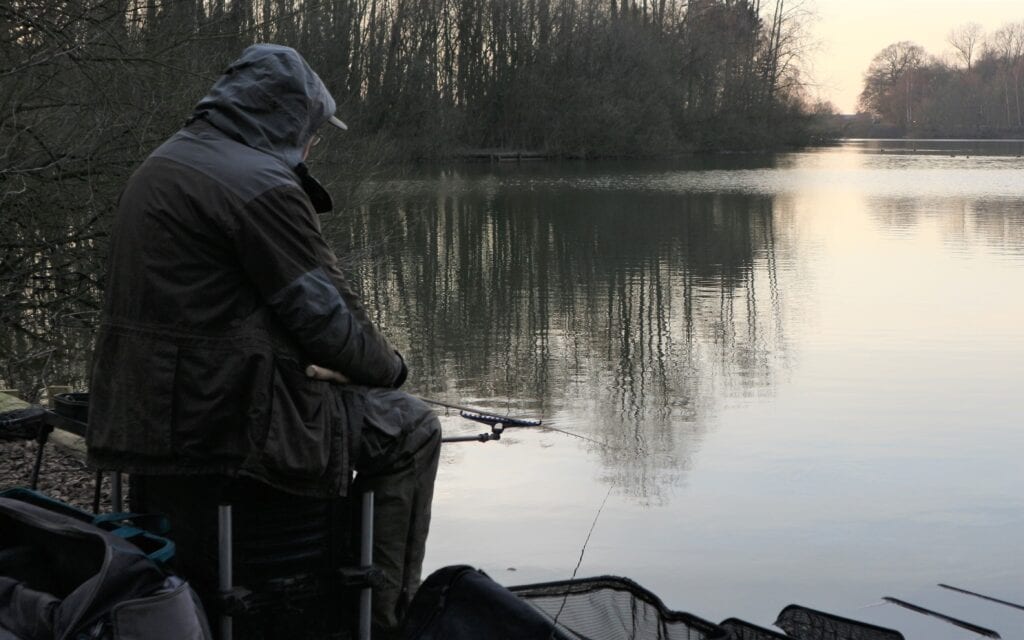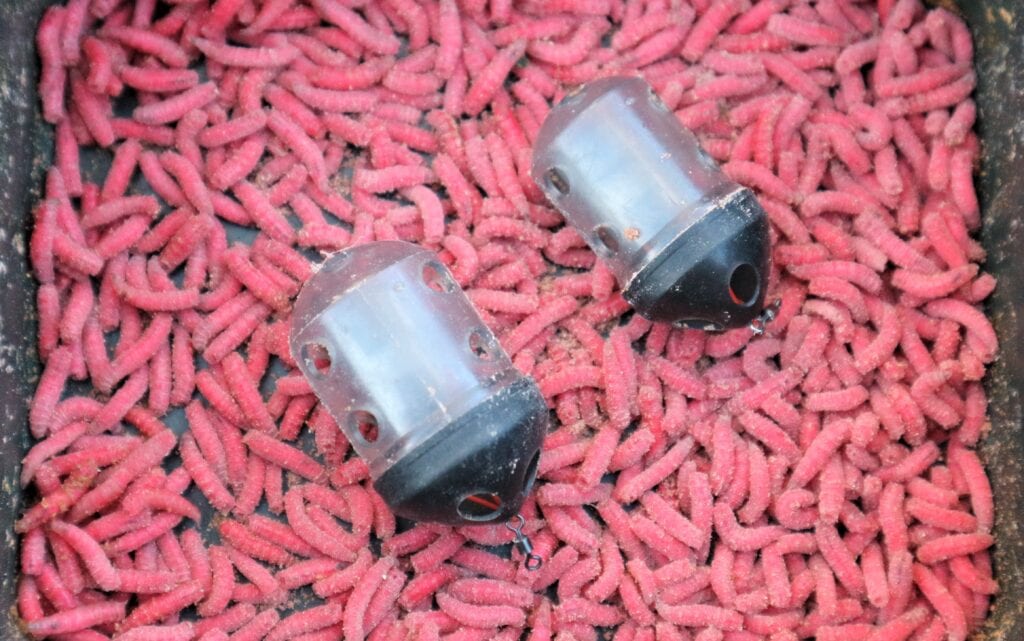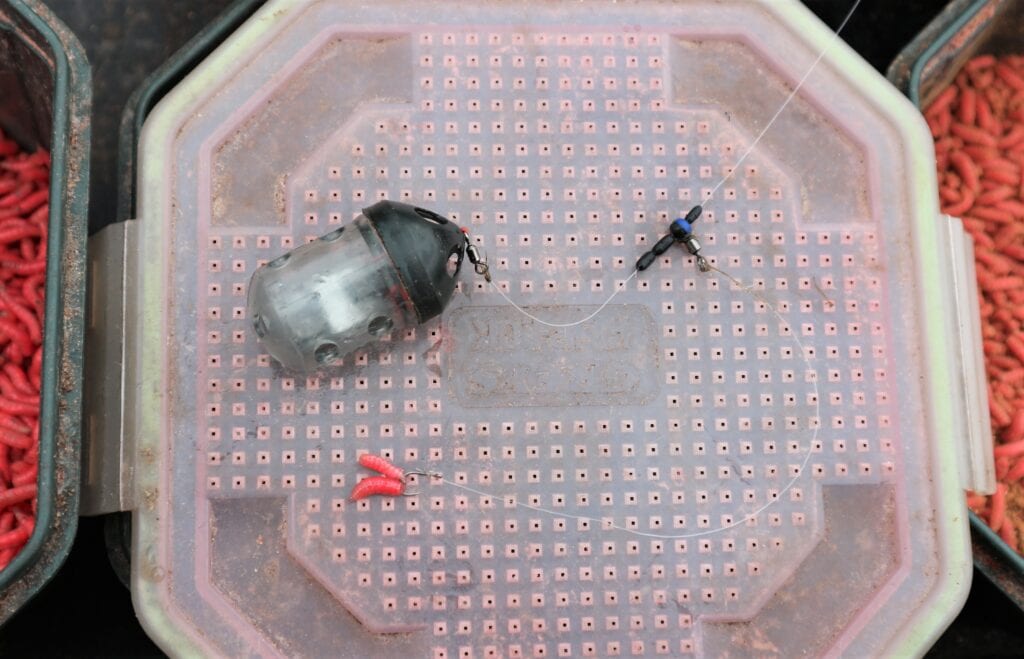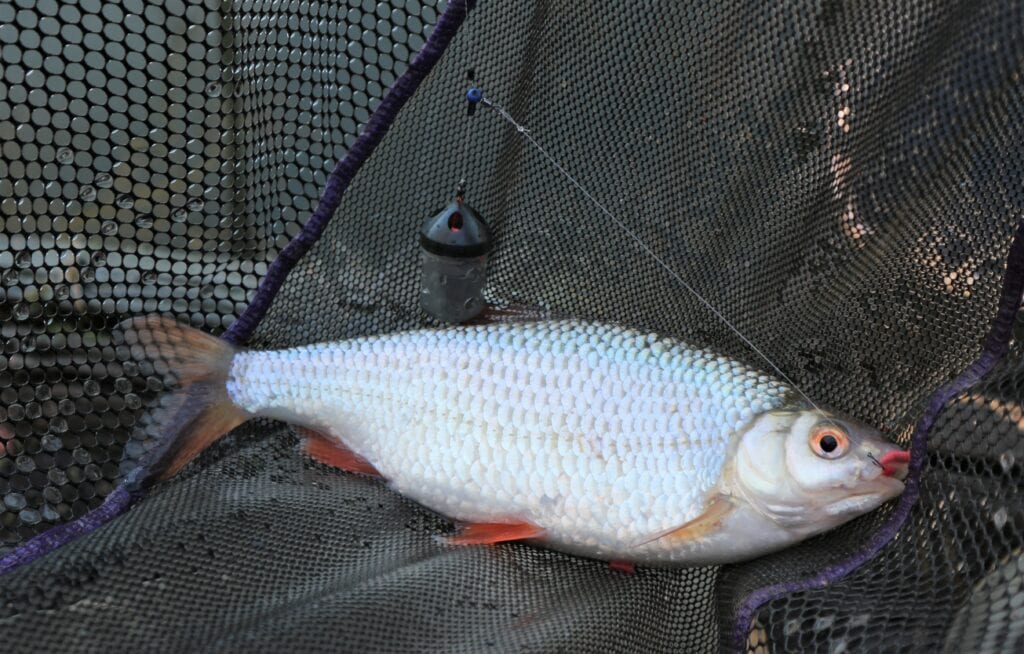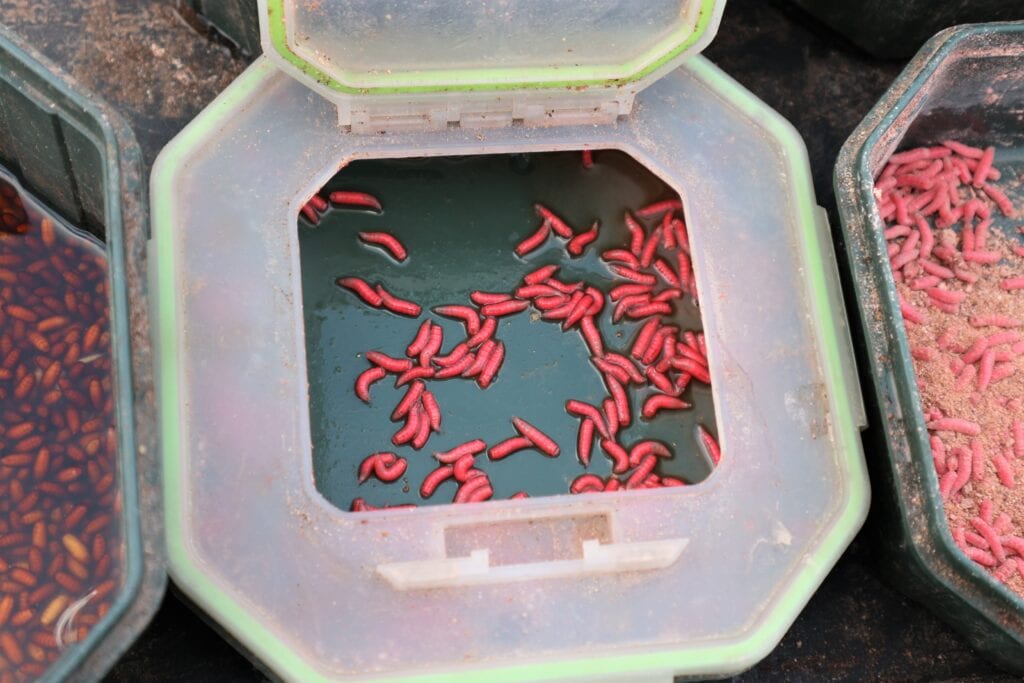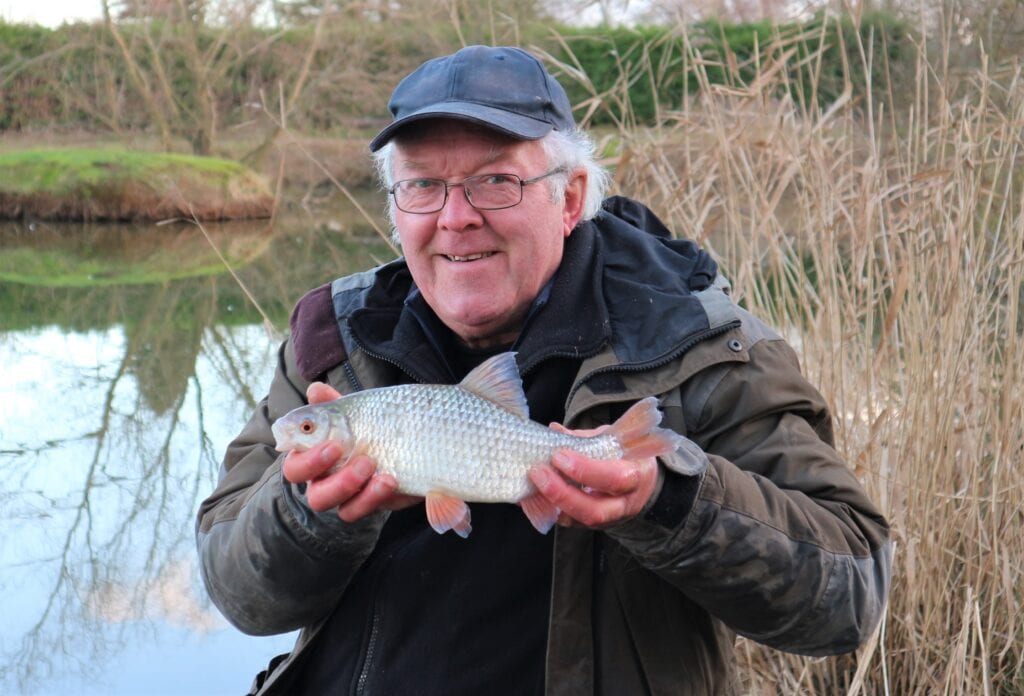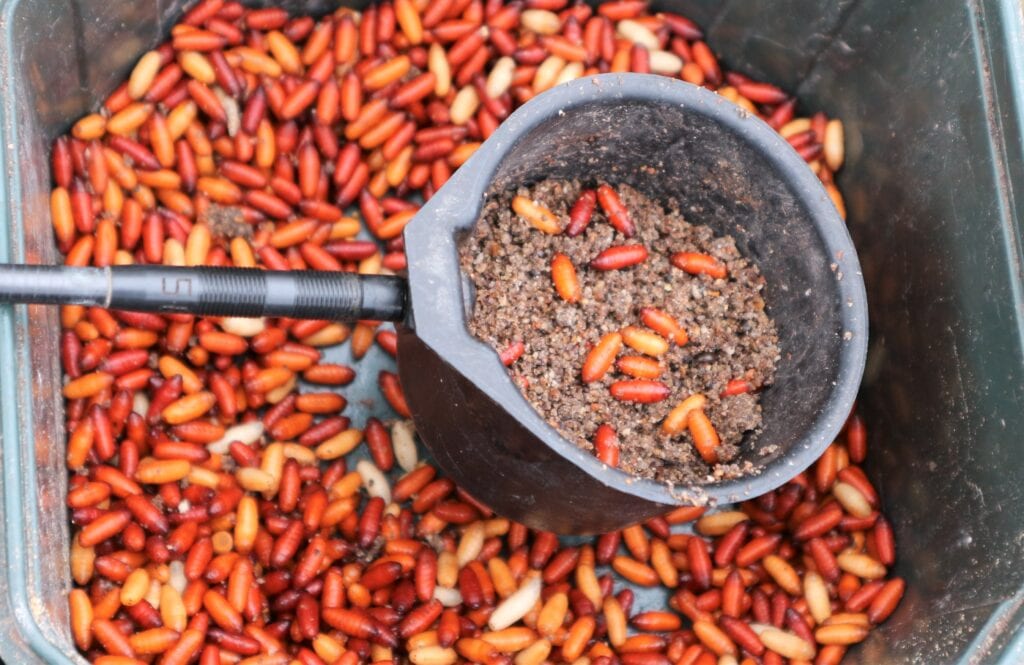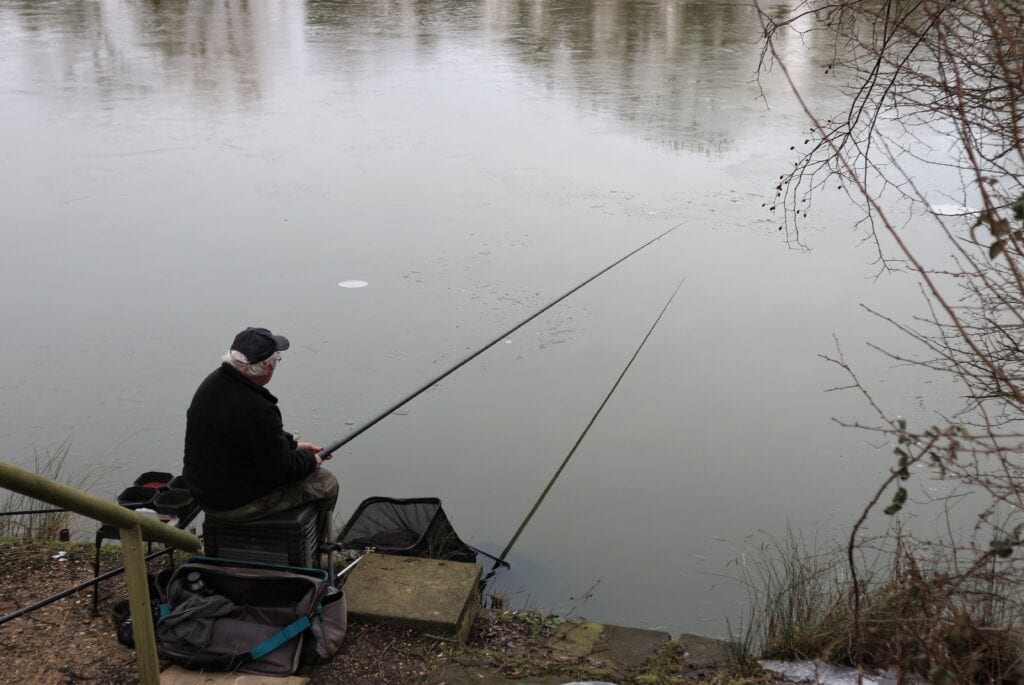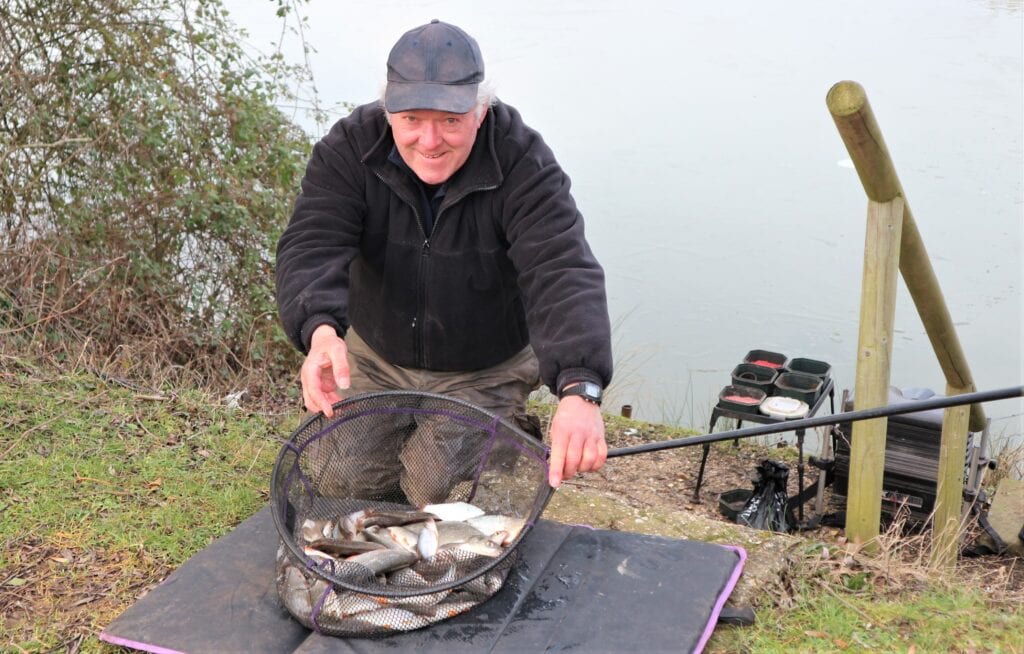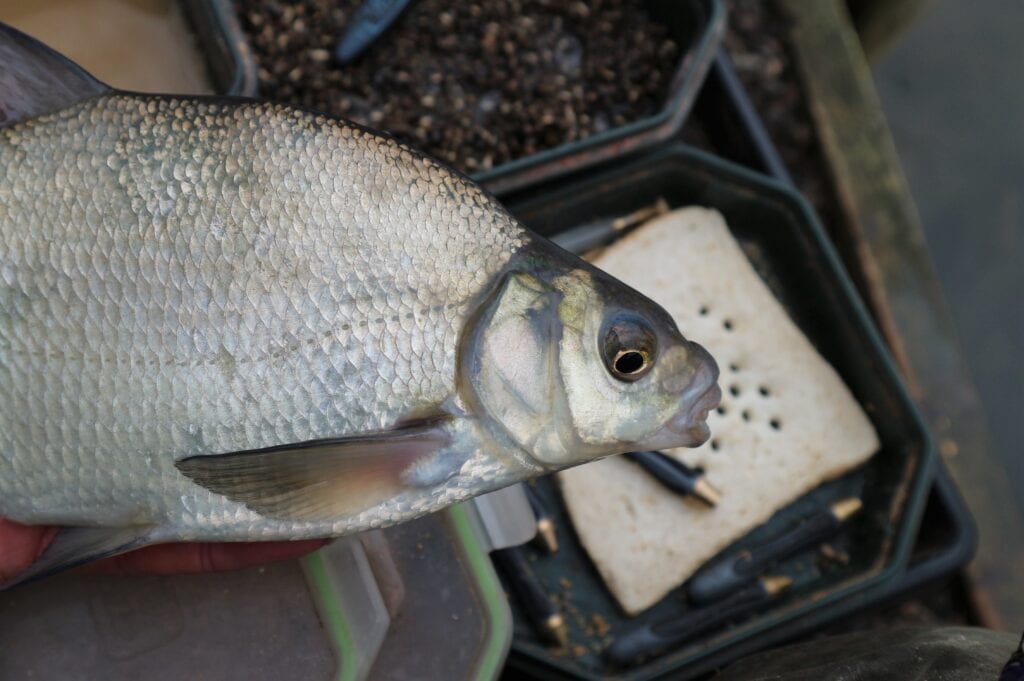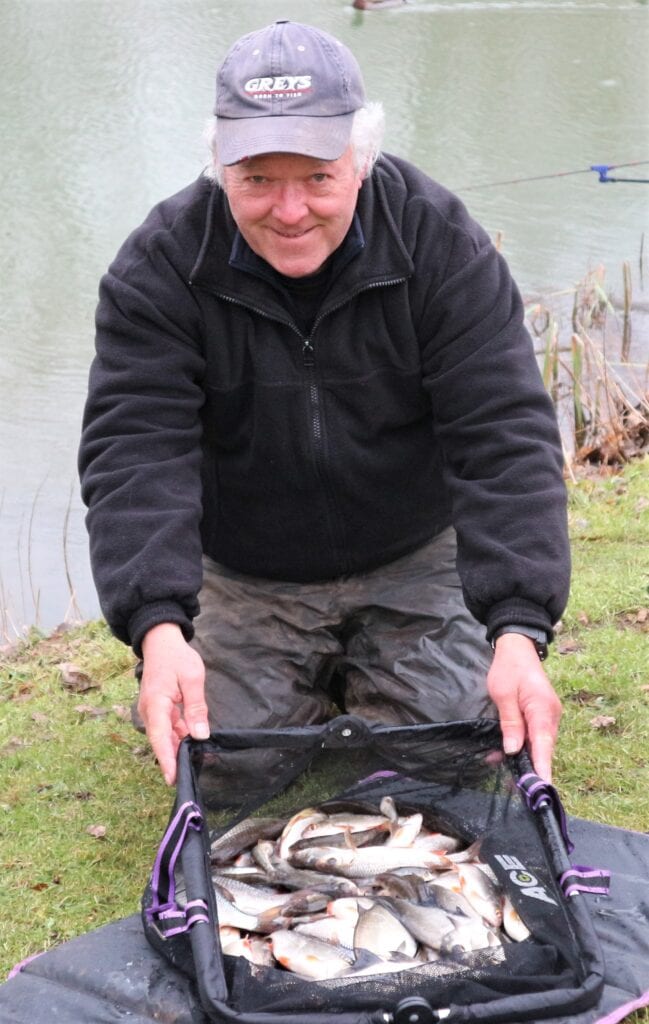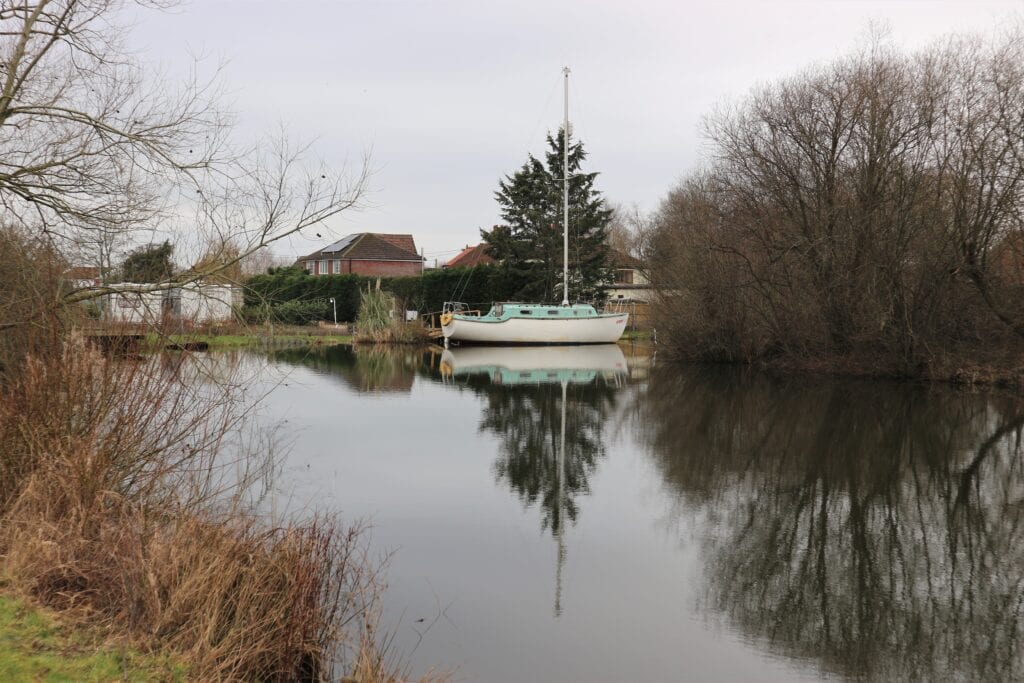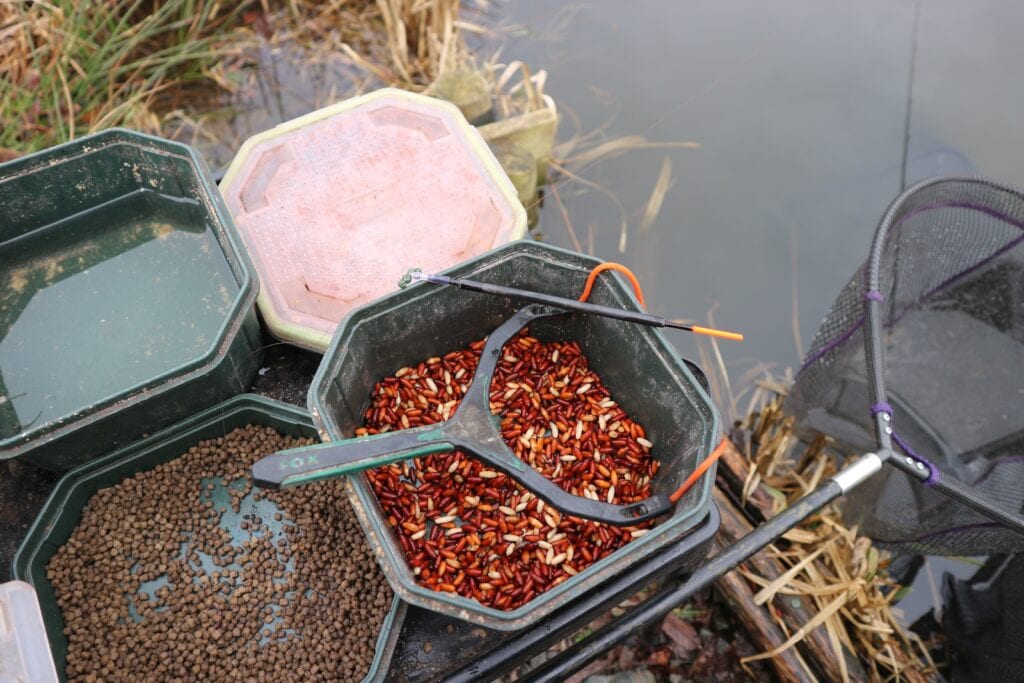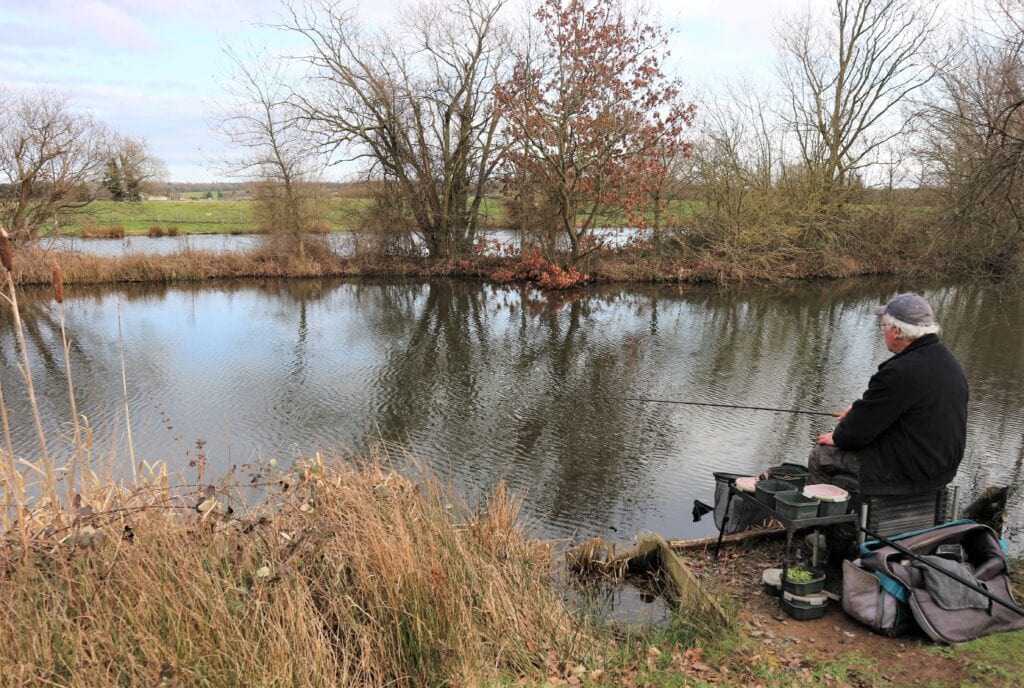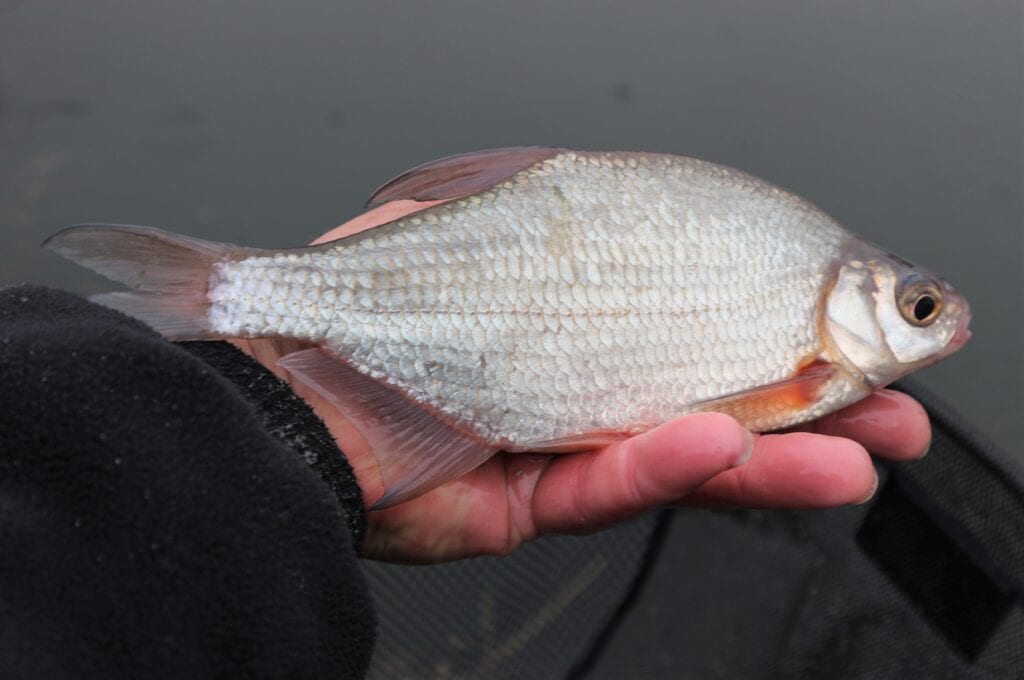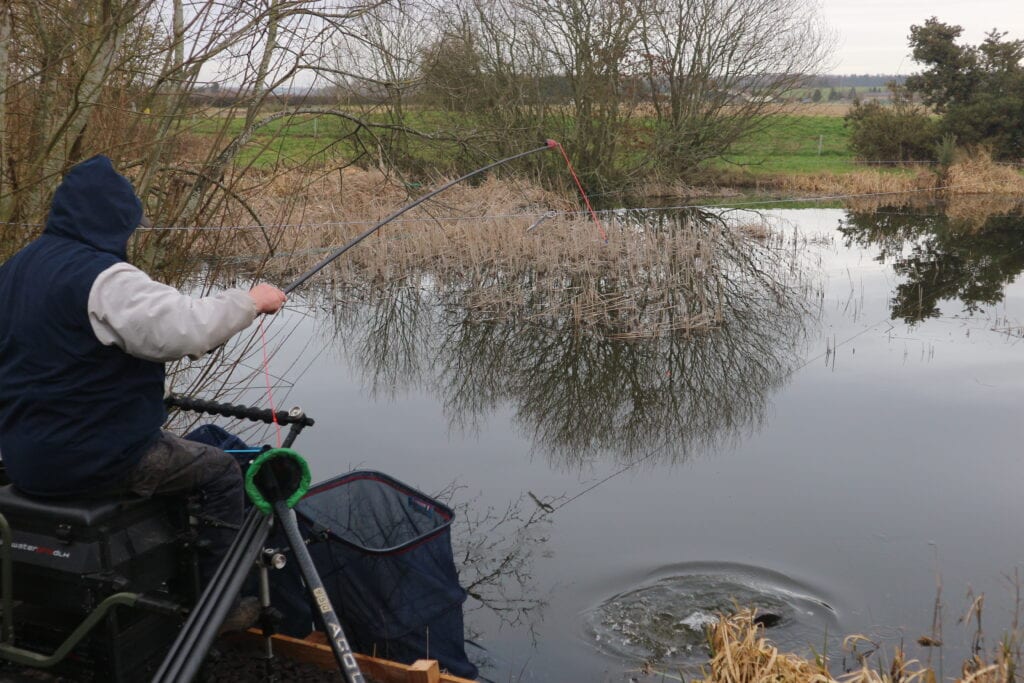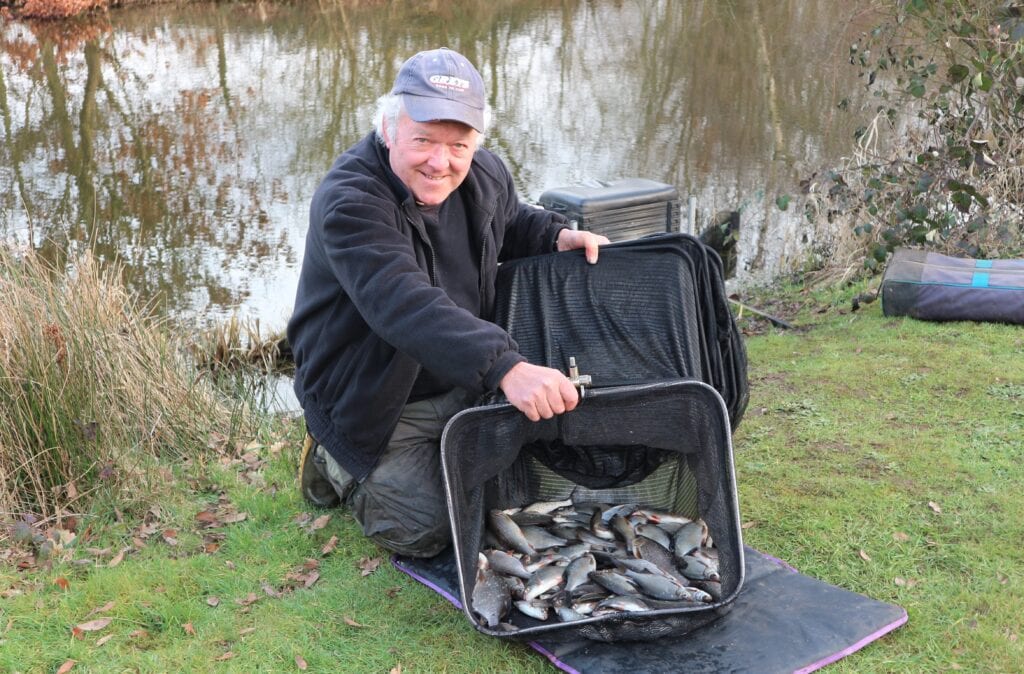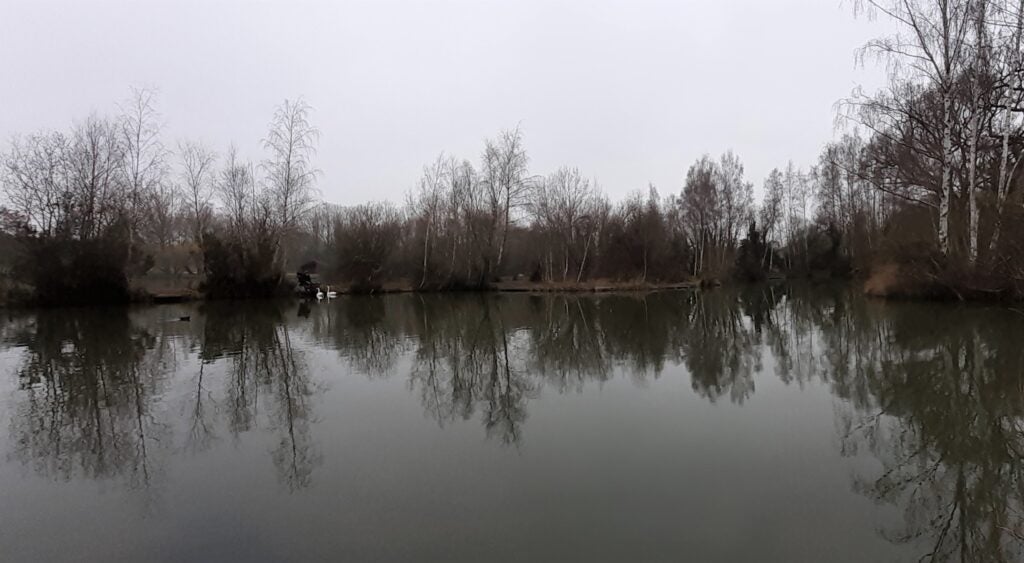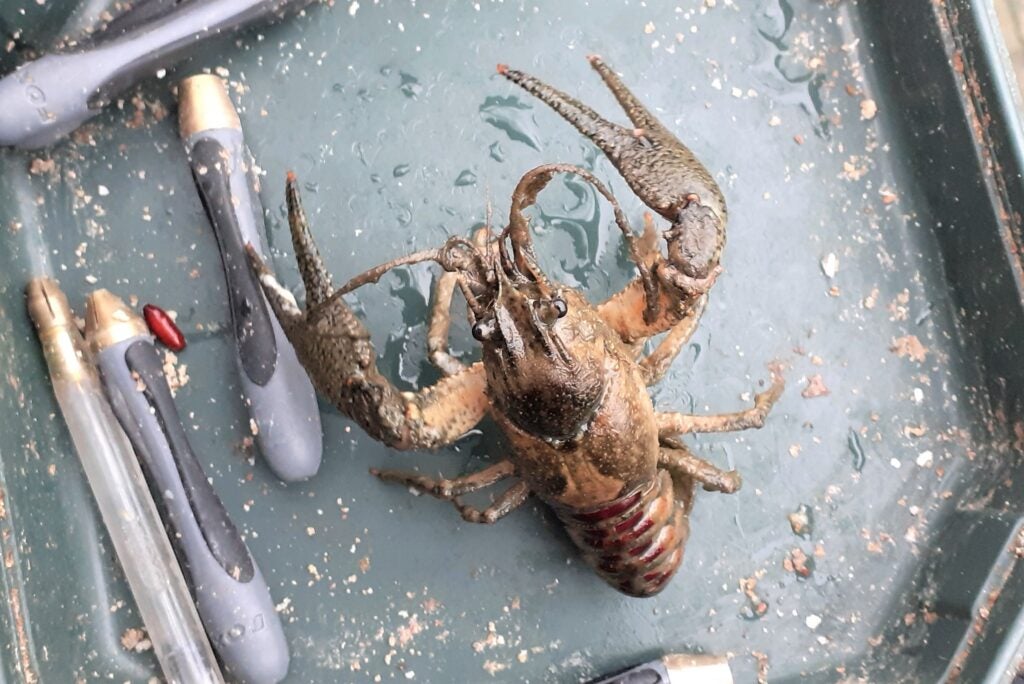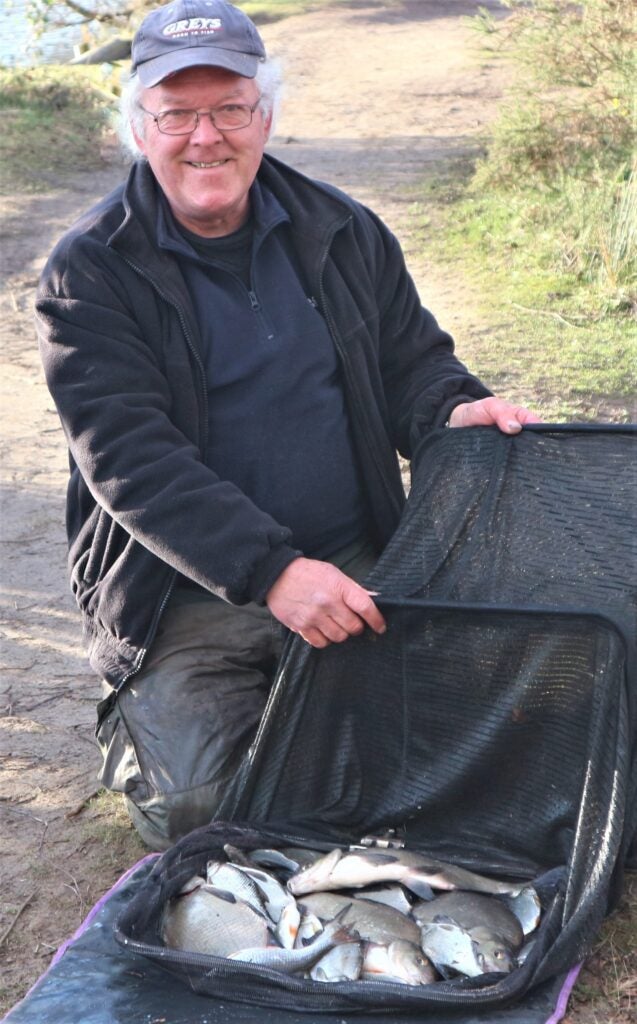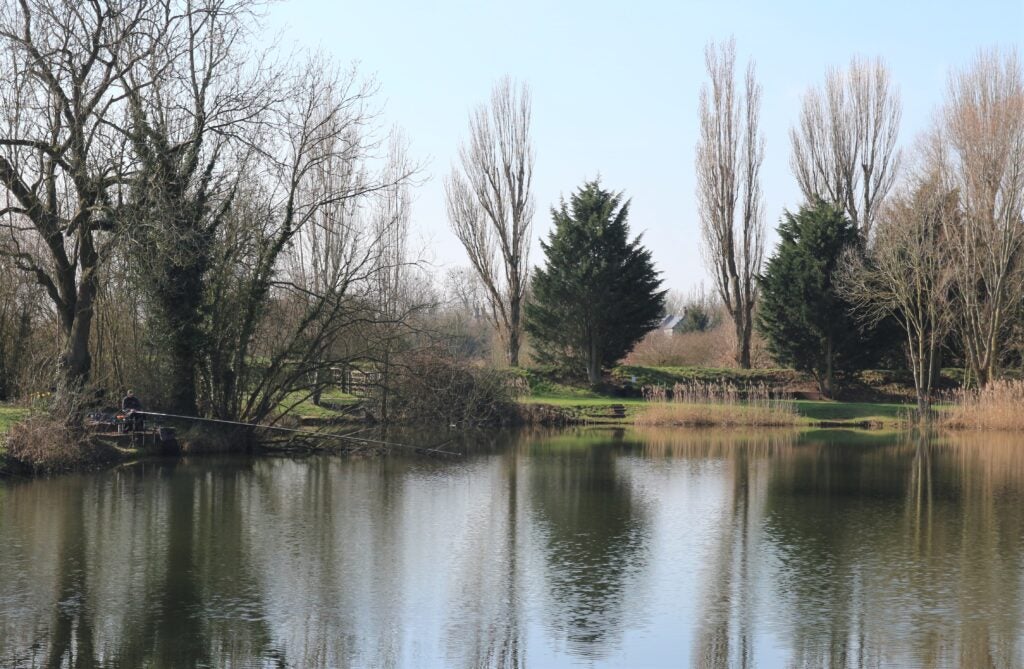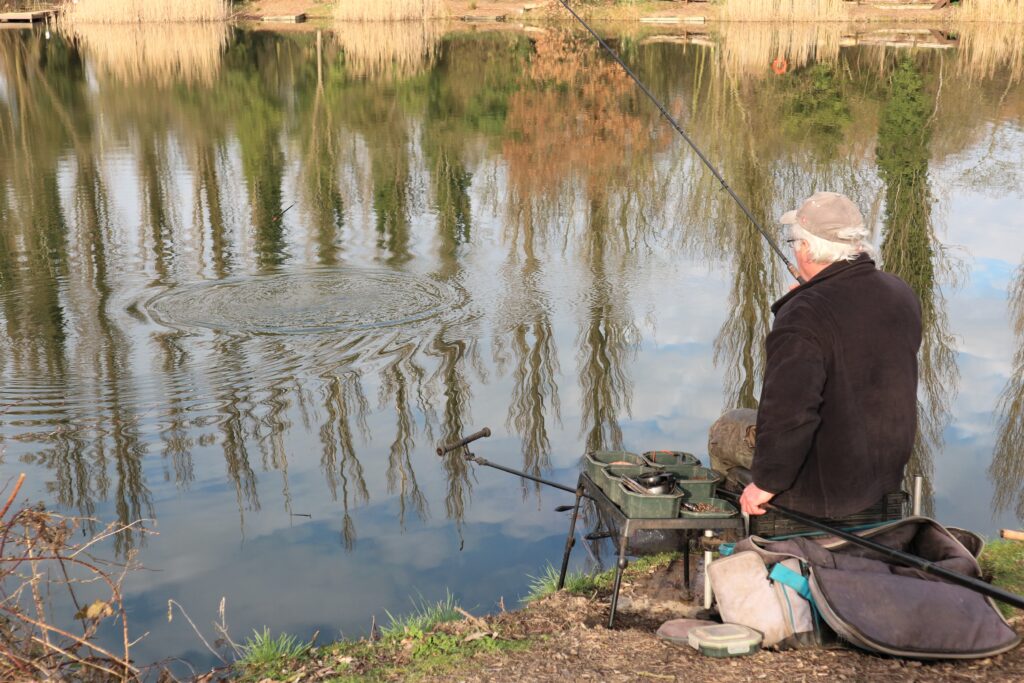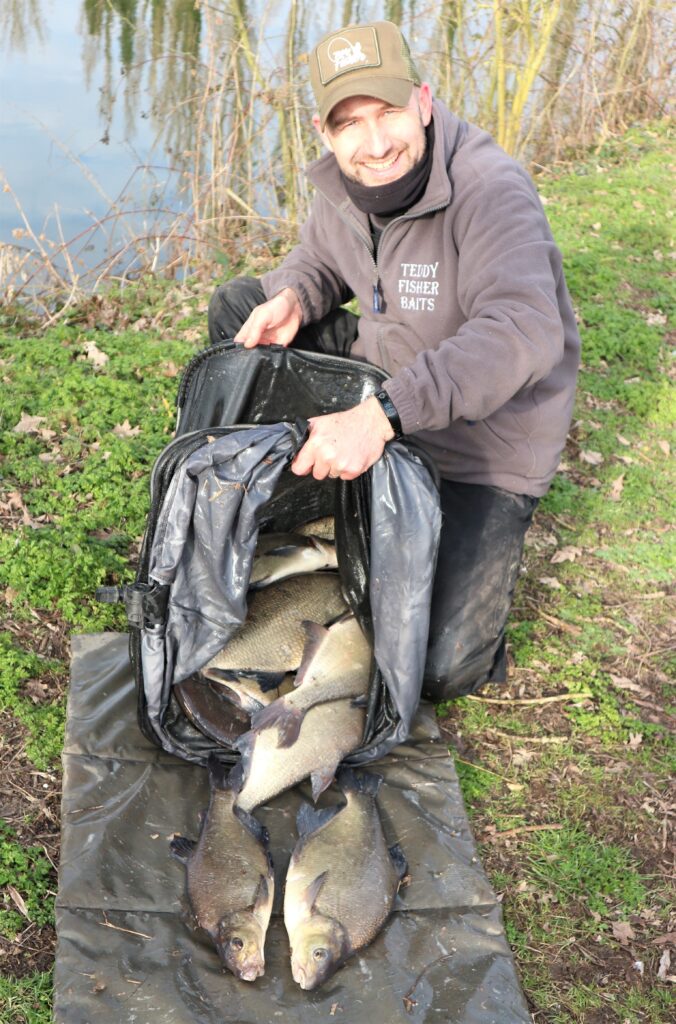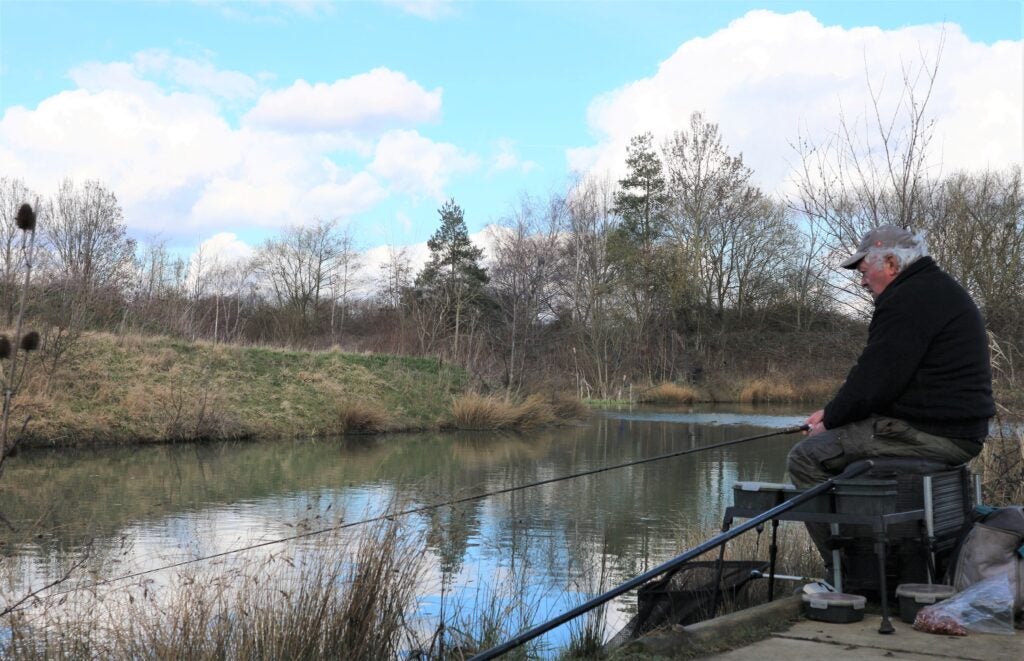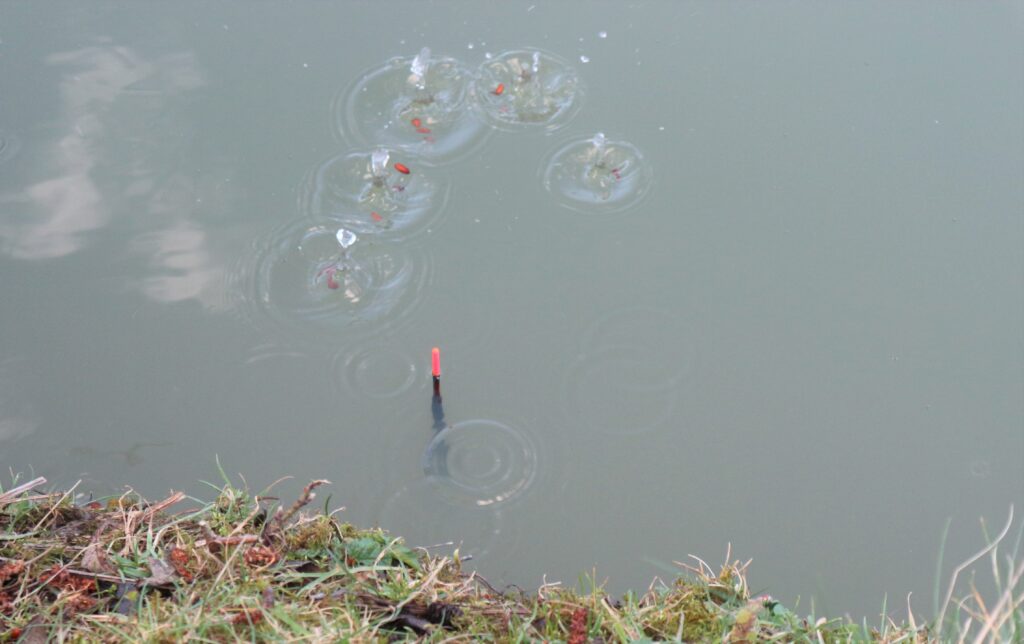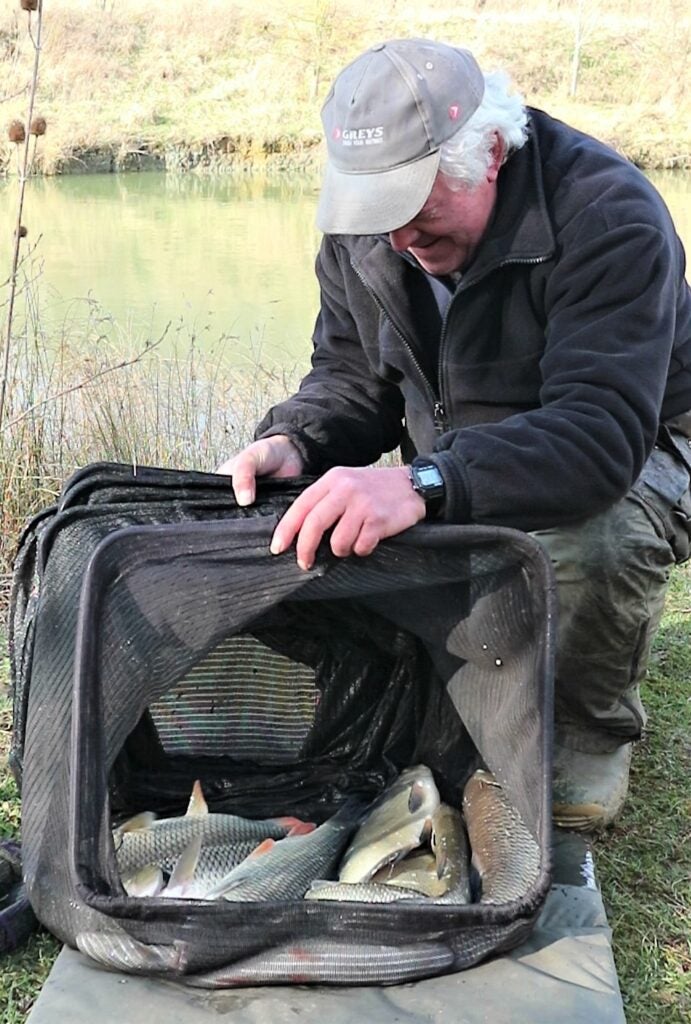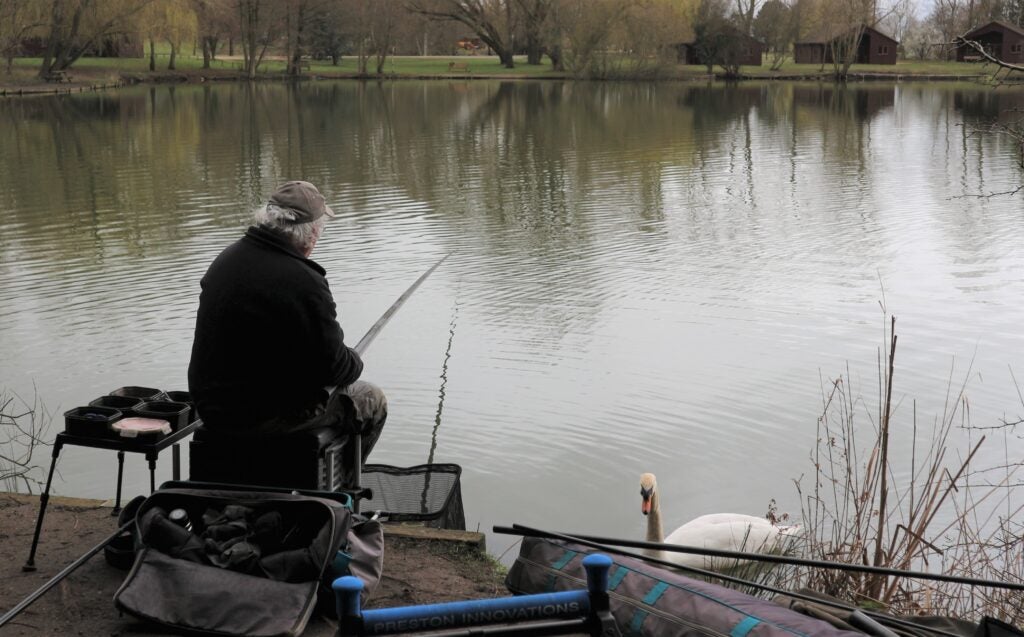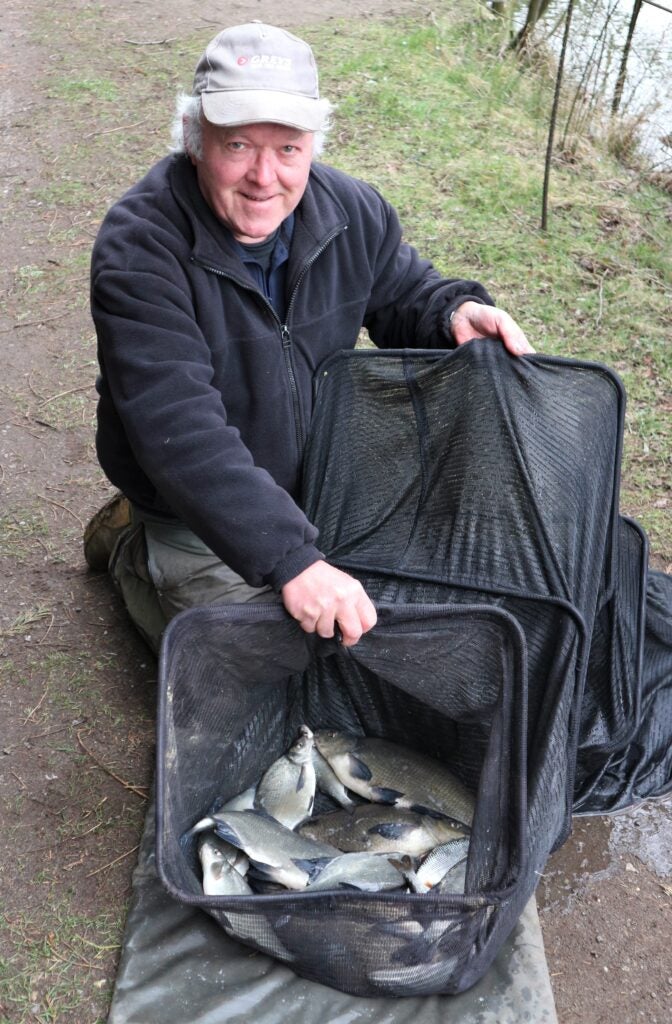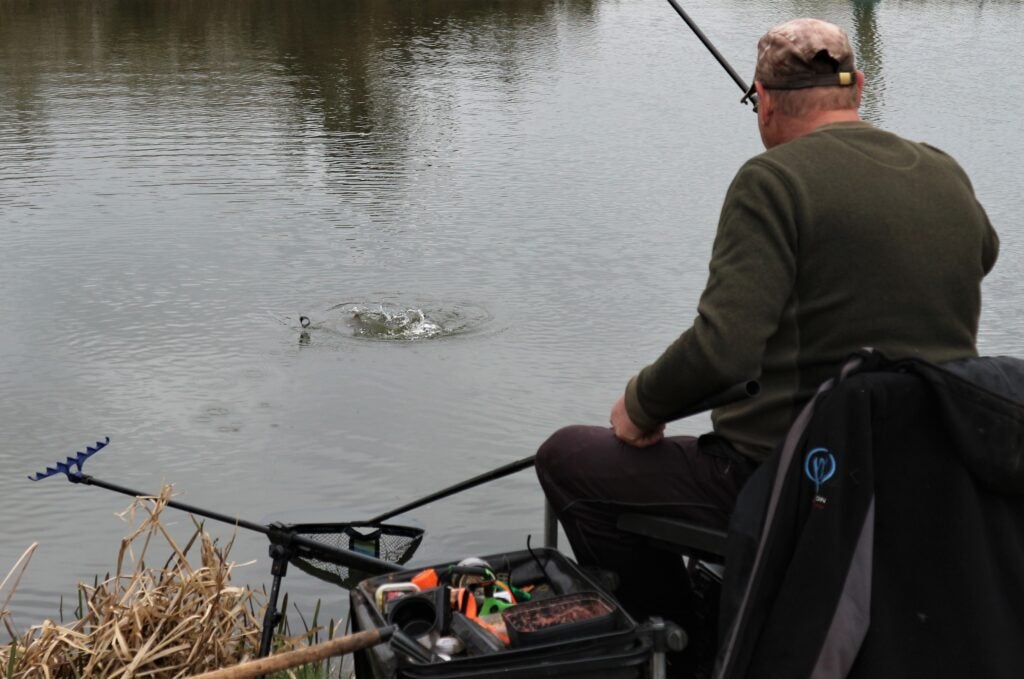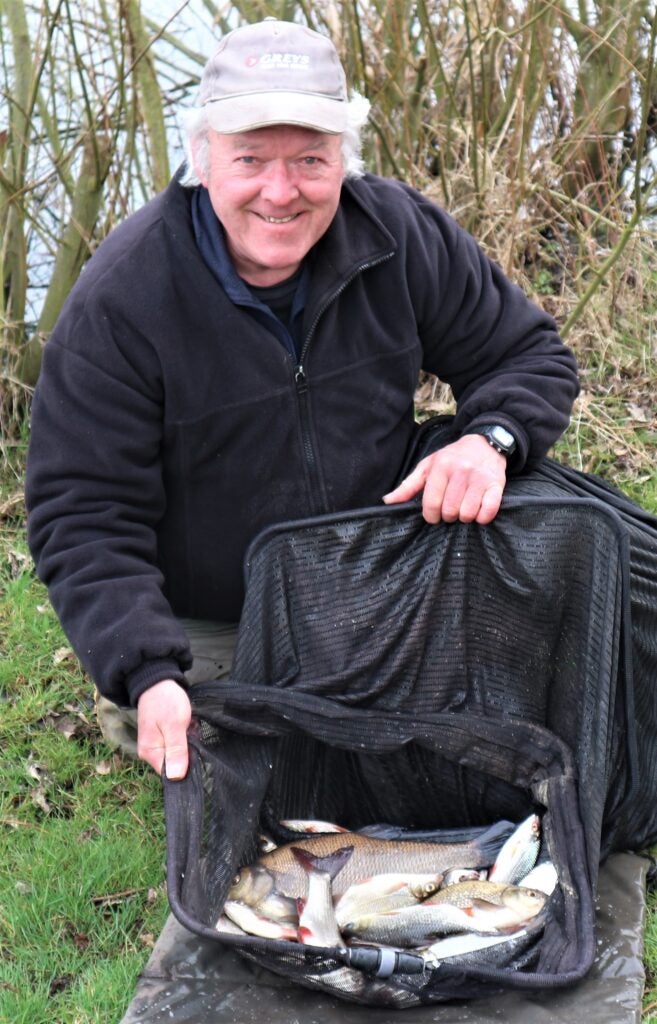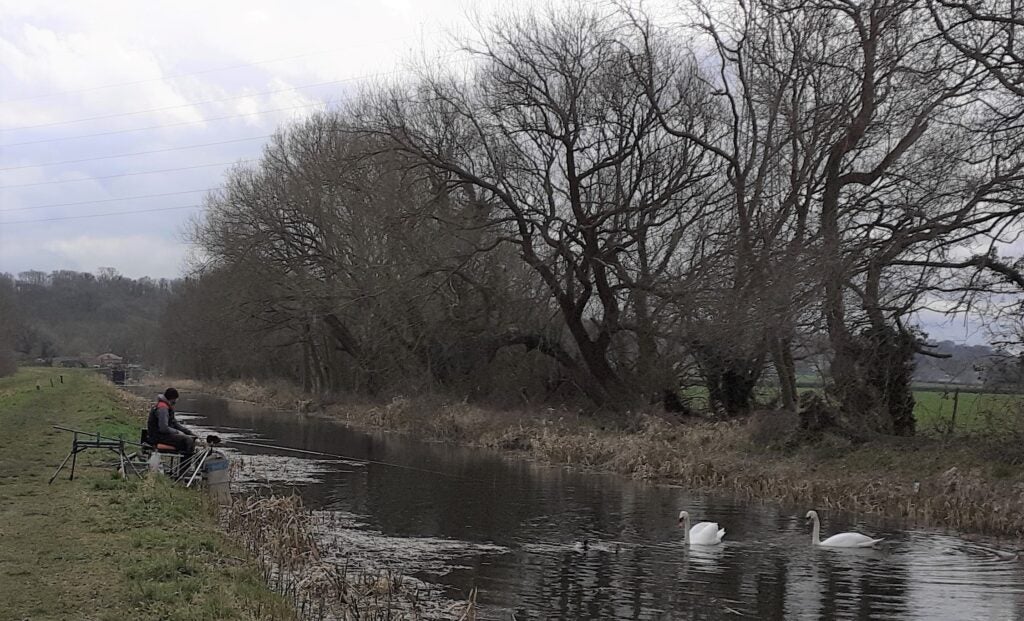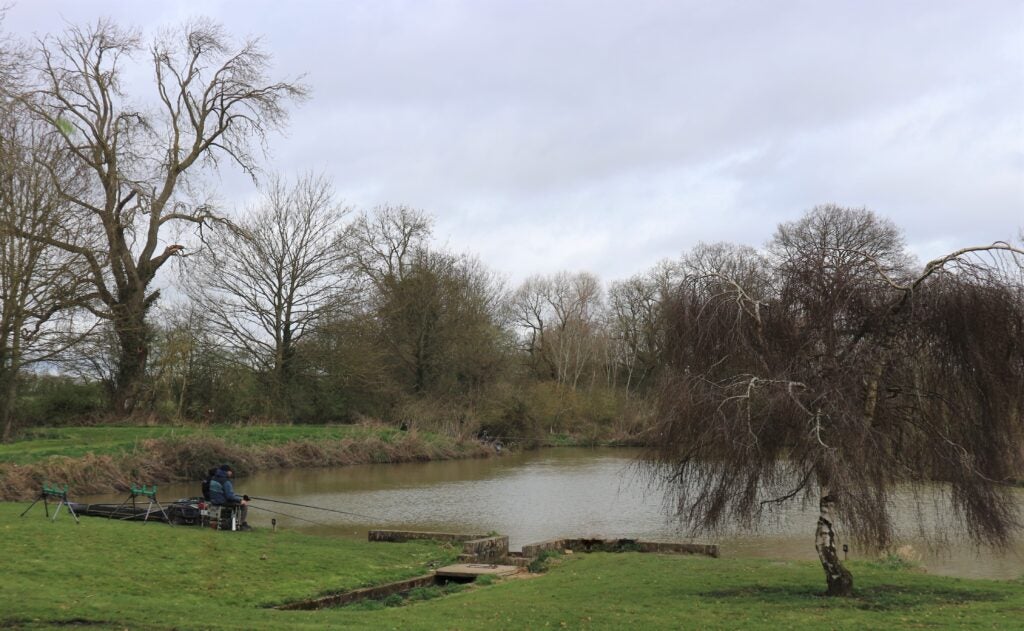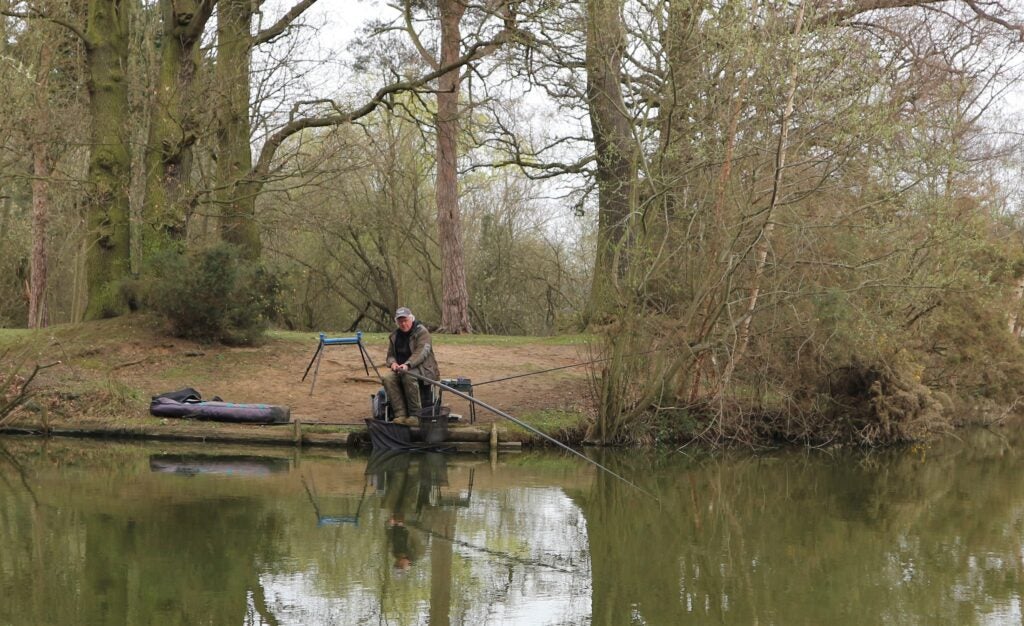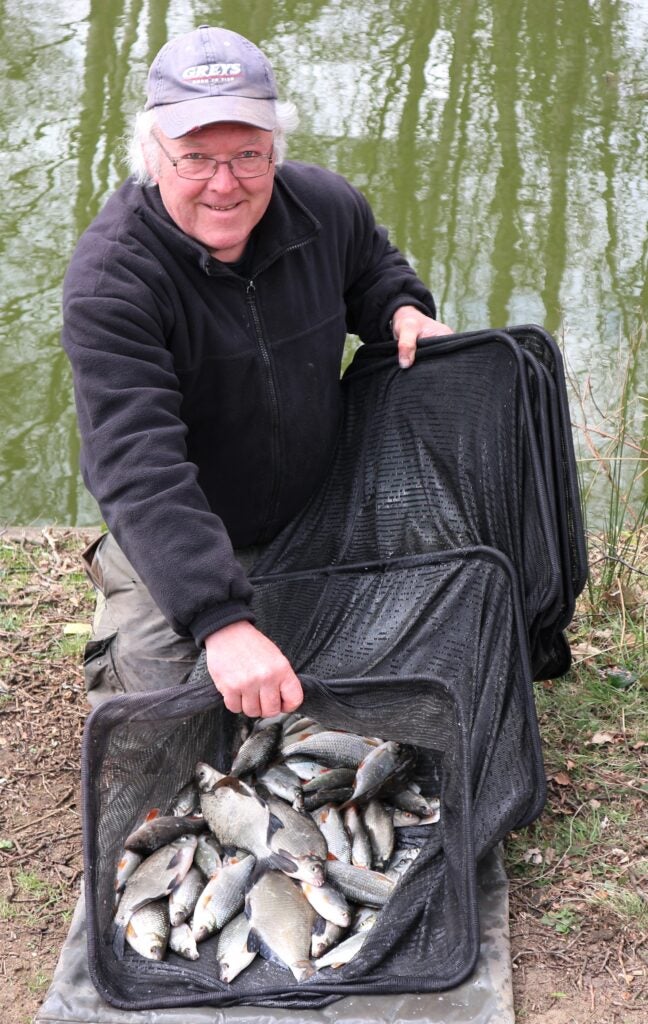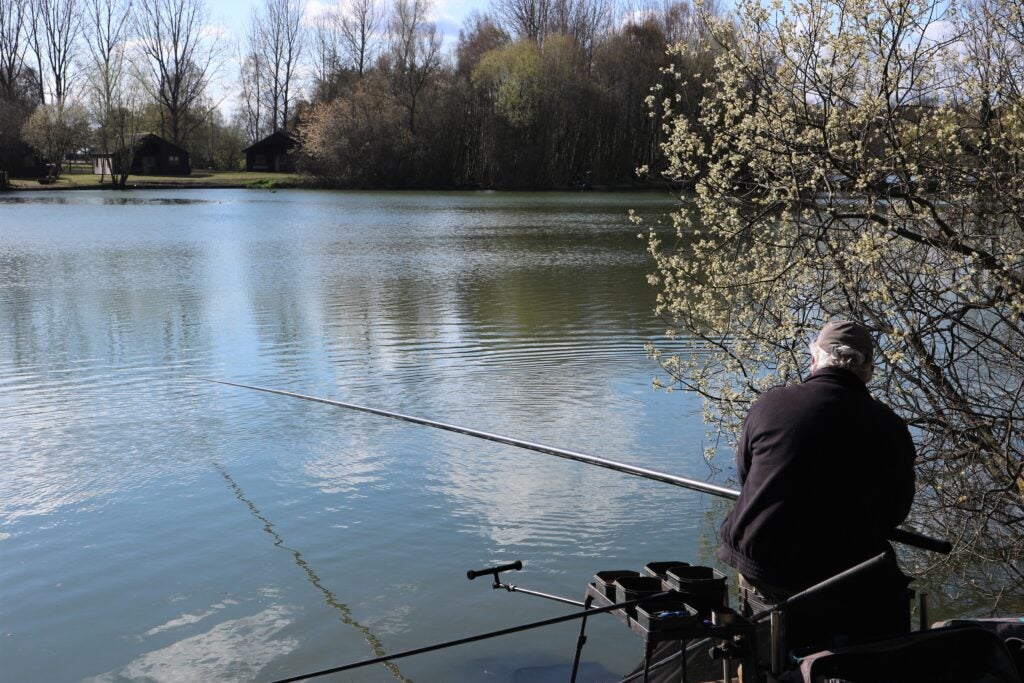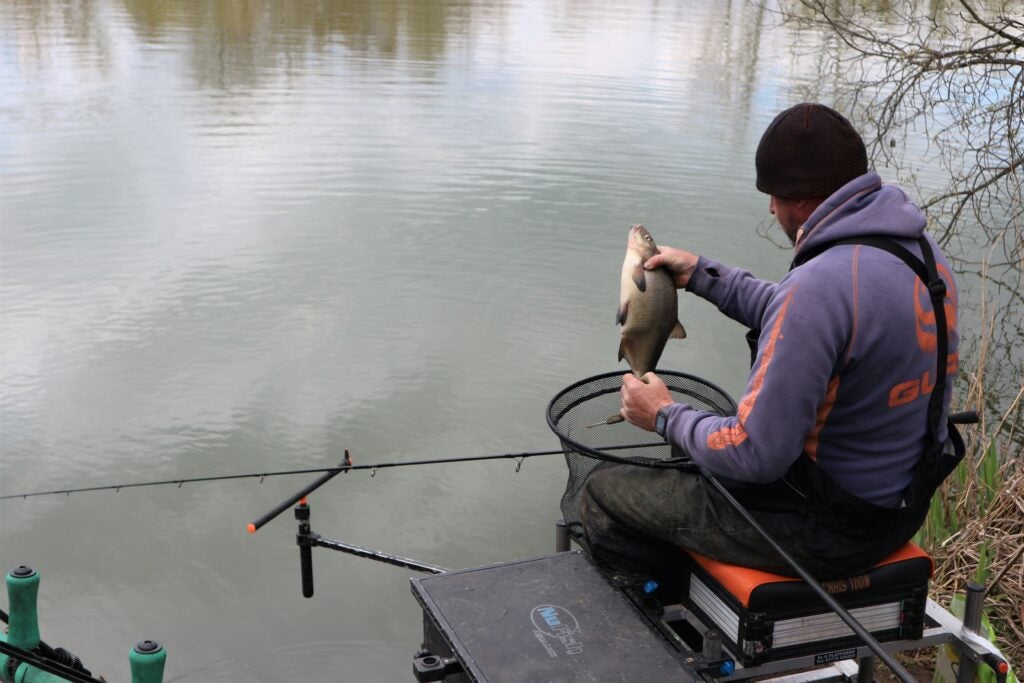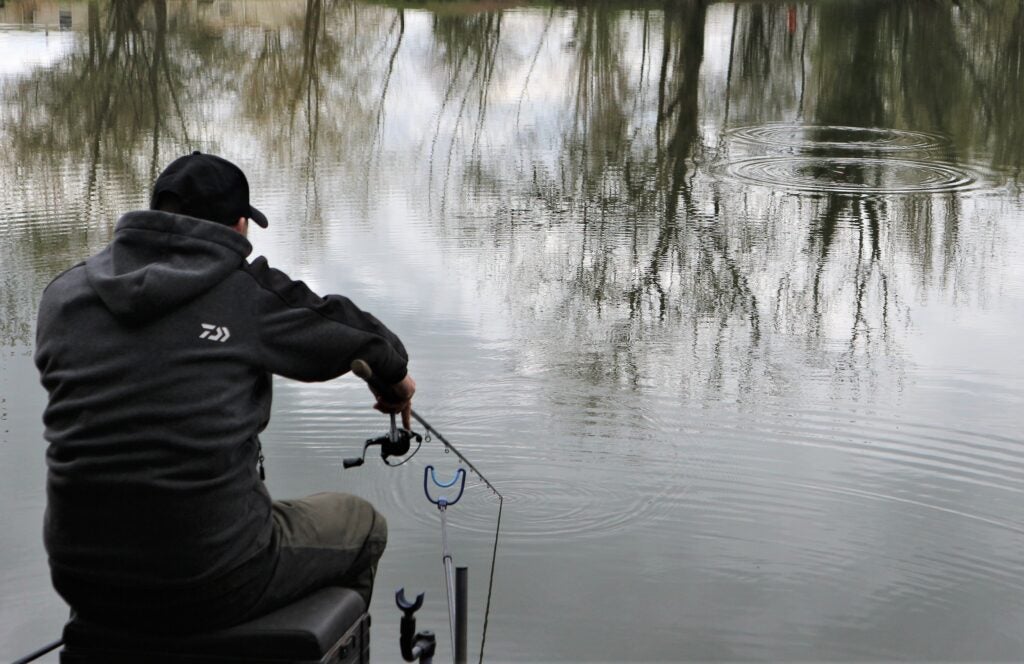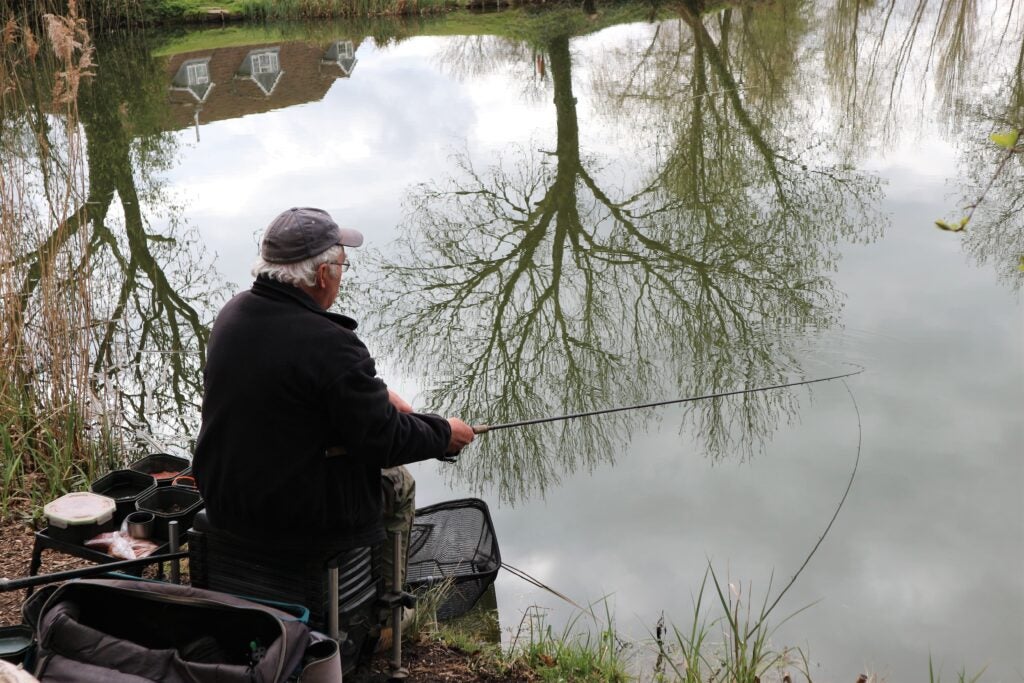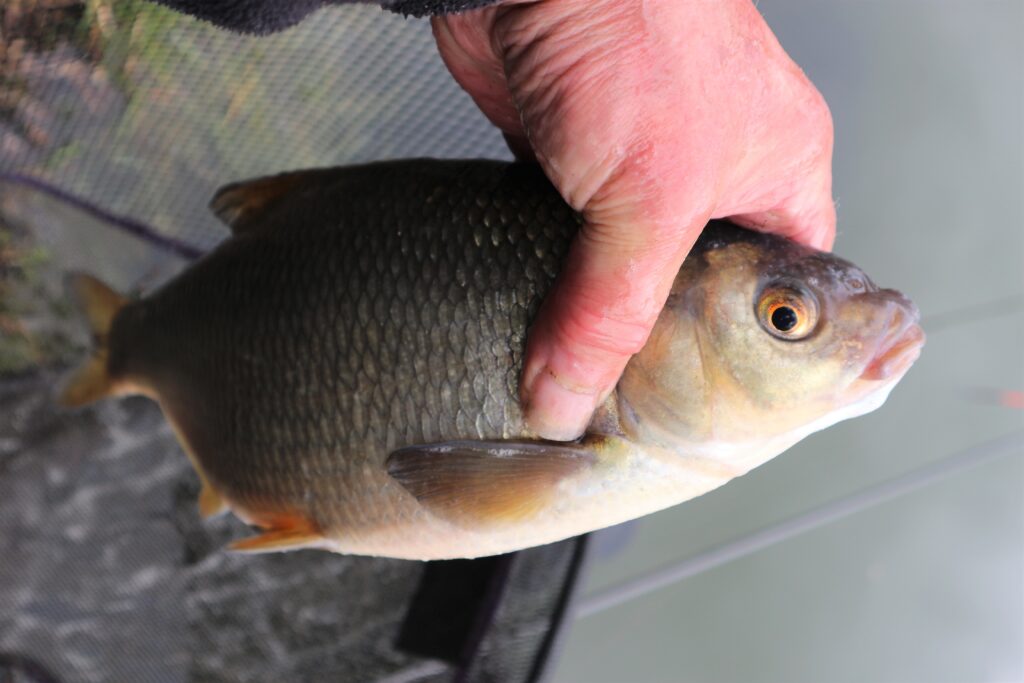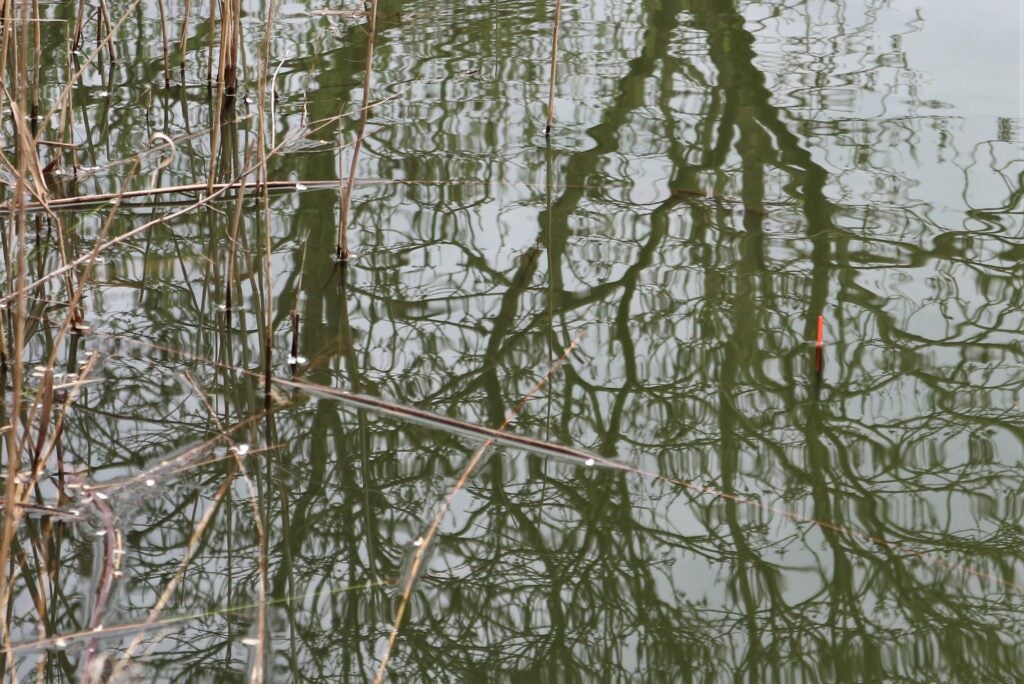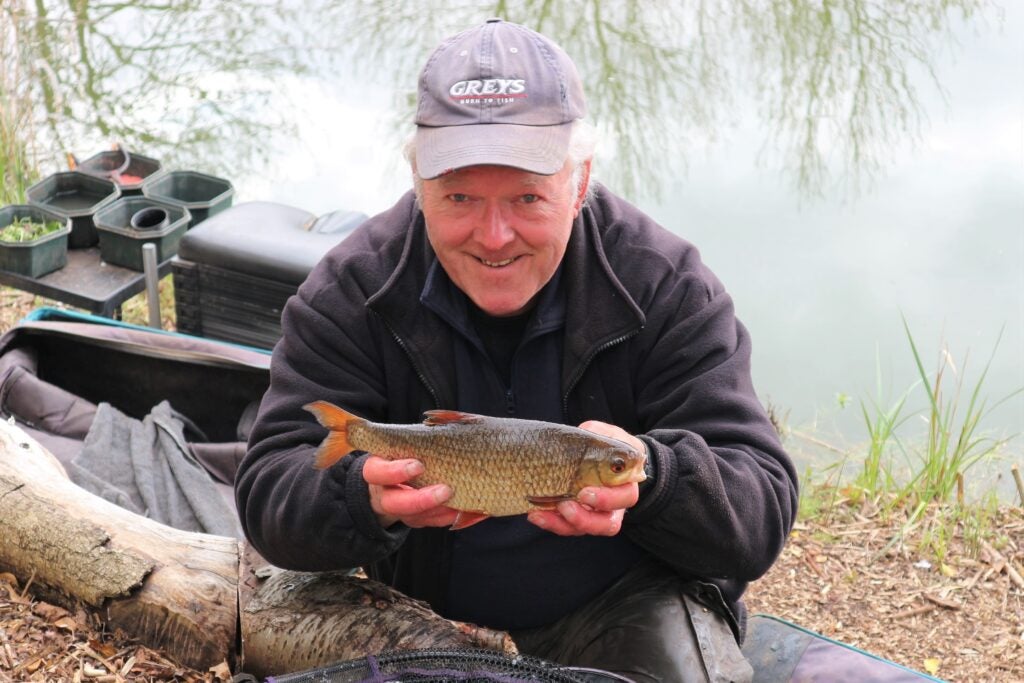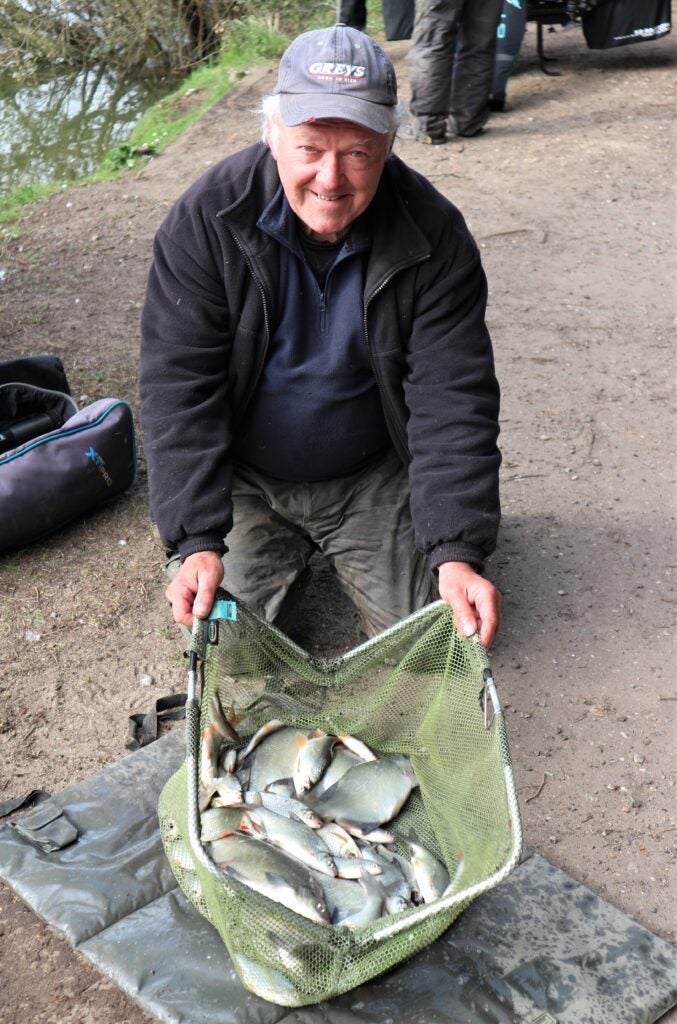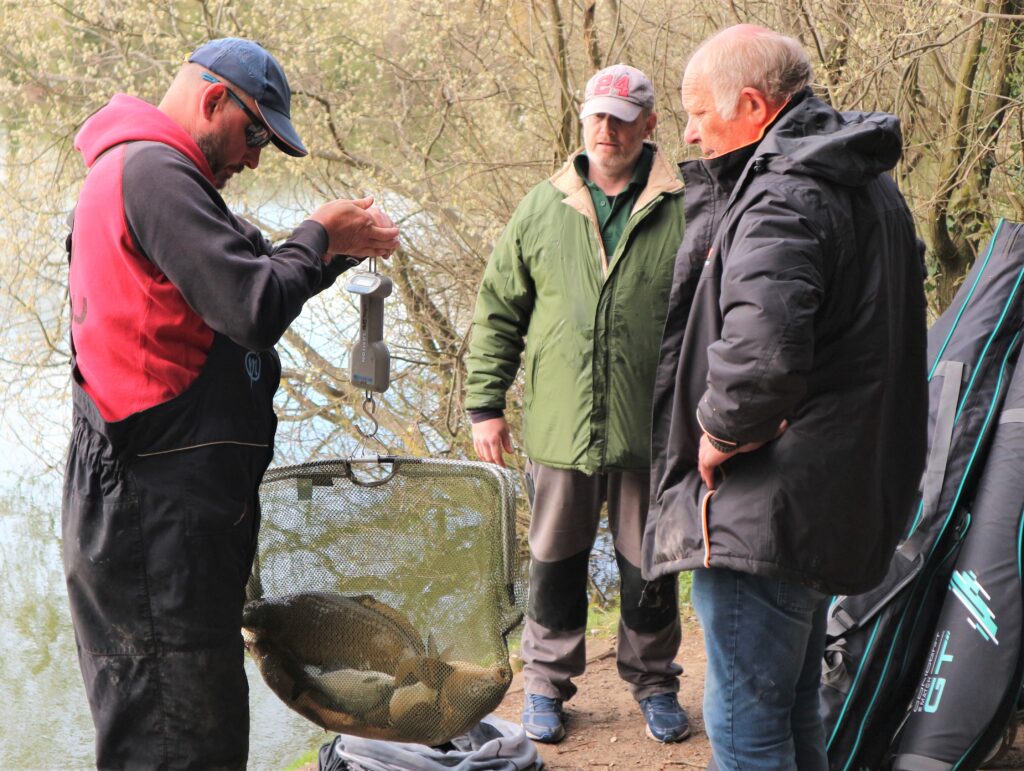D
Dave Coster
Guest
Dave Coster's Fishing Diary – December
MISSING THE BUS

Spalding is only 40 minutes’ drive from where I live, and behind a big shopping centre called Springfields lies the Coronation Channel, which I’ve walked a few times while the wife enjoyed exploring the various discount outlets. On our latest trip I spotted a couple of anglers fishing with poles down by the tidal sluice. Fish were topping on the surface everywhere and the pair of locals were catching lots of skimmers and roach. I chatted with one of them and he told me the place used to be a popular match venue but was barely fished these days. He reckoned it can still produce top sport and that, apart from what he was catching, big bream and tench were a possibility as well. I returned a few days later with my mate Chris from Grantham. Conditions looked perfect but to cut a long story short, we couldn’t buy a bite between us. The water looked dead compared to what I had witnessed before, with two warring flocks of swans the only living things disturbing the surface. This prompted us to make a move to the nearby River Glen.
BACK ON TRACK
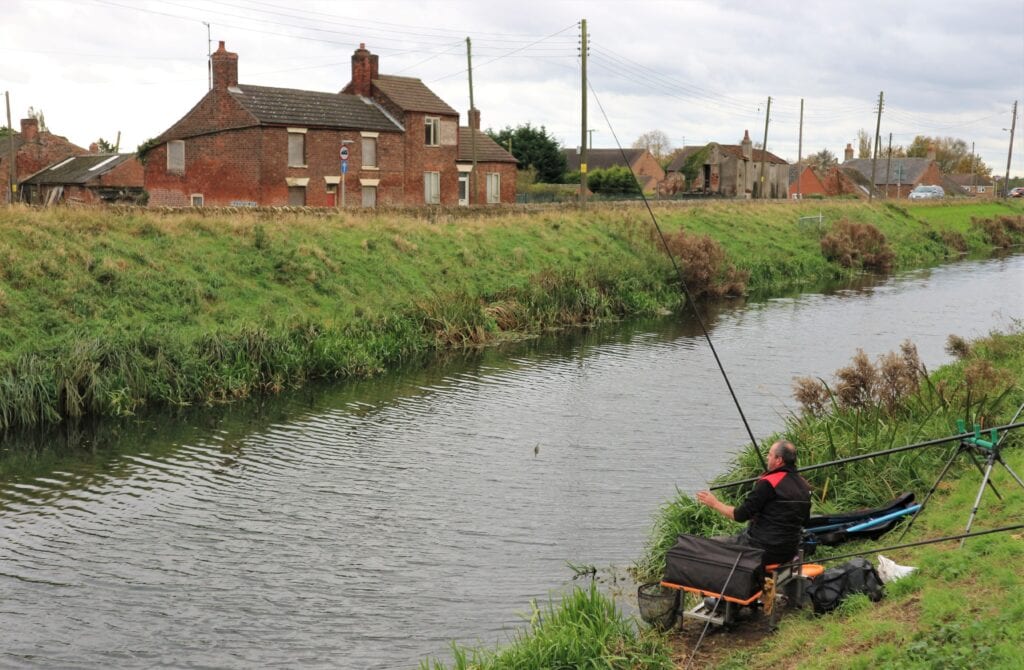
It soon became apparent where the fish had gone. The huge shoals of silvers that migrate into the smaller fens and rivers around Spalding during the colder months had obviously started moving early. The Glen at Pinchbeck was heaving. It’s only a narrow waterway, more a drain than a river, with steep dredged banks and little flow. But I’ve enjoyed some great sessions here during previous winters, particularly with the big perch, which run to specimen size. It quickly turned into a bite every put in fishing with pole tackle, mainly from small roach, skimmers and perch. A chilling wind was blowing hard downstream, which made it tricky to fish long. Chris and I mainly concentrated closer in, using maggots, casters and worms over groundbait. Towards the end of the short session, Chris caught some fair-sized perch, while when the wind dropped occasionally, he also found better roach dropping a rig close to the far bank. Other species that turned up were rudd, dace, bleak and small hybrids. A pike trashed a rig, but the monster perch didn’t show.
IN THE FLOW
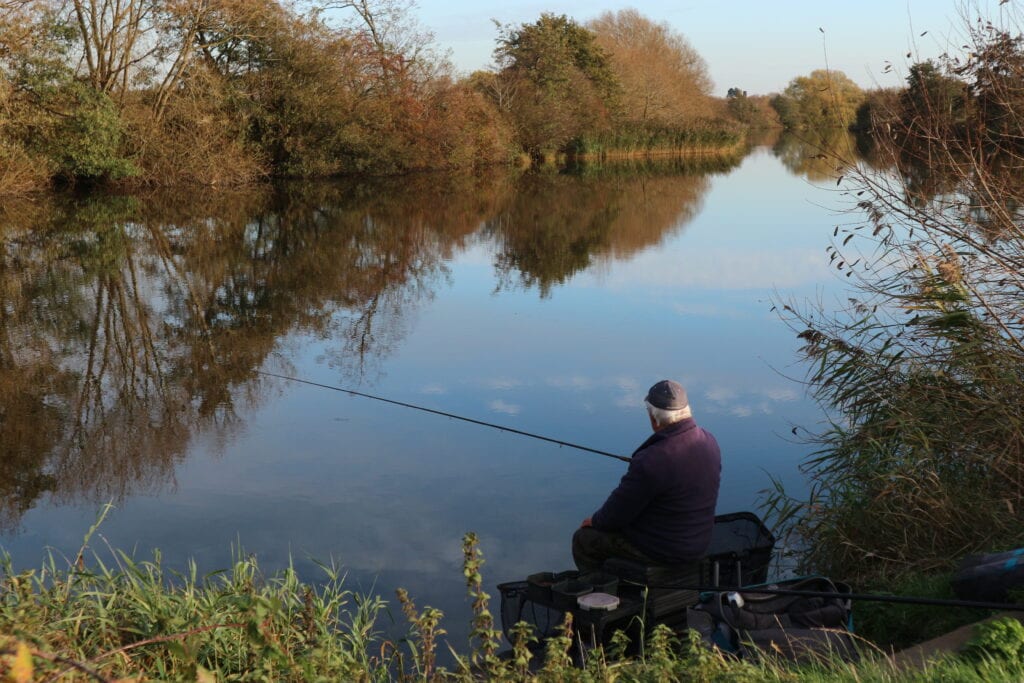
The River Trent at Farndon is even closer to where I live, just twenty minutes down some back roads. The flow steadies off nicely downstream of the power station and weir, producing perfect conditions for a stick float, a form of fishing which is in danger of becoming a lost art. Many years ago, just about all anglers could be seen using sticks on the Trent, armed with several pints of maggots. But currently most people are targeting the big barbel, which entails having a couple of beefy specimen rods pointing skywards in support pods, very often with a pellet and boilie orientated attack.
It only took me 30 minutes to get bites, feeding a steady stream of hemp and casters, using a 4 number 4 capacity stick float and a size 18 hook tied to 2lb line. After that it turned into a hectic session, catching lots of pristine roach up to 8ozs and a few dace. Nothing big turned up, mainly because the river was running clear, but it was still great fun fishing this way, which keeps you active and warm during chilly winter days.
LAKE ACTION
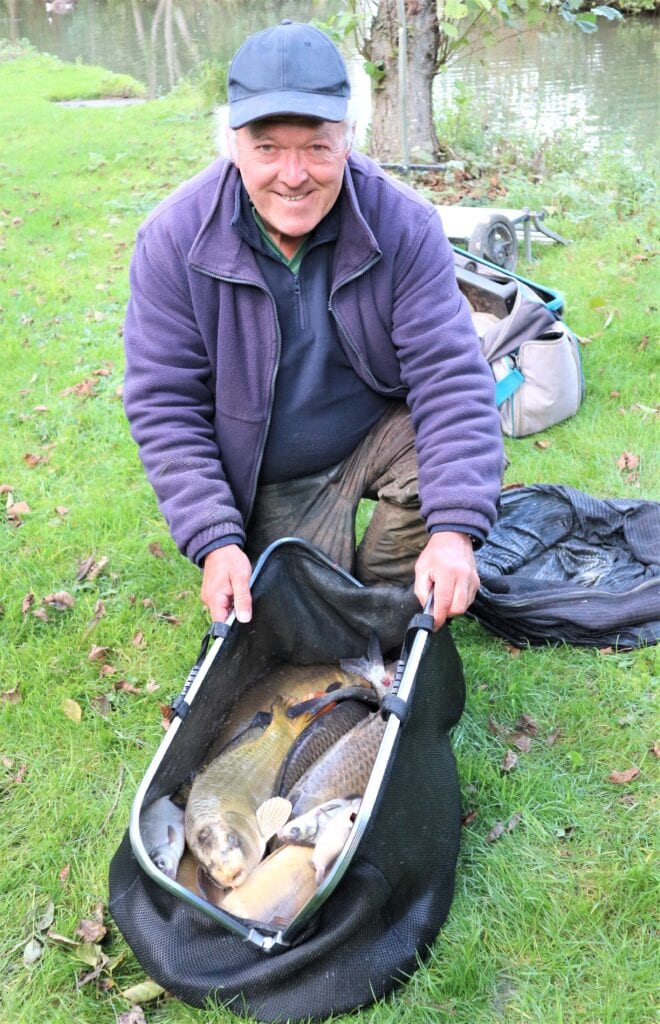
A local angling club match was my next outing on Willow Lakes at Foston, just off the busy A1. The water was coloured after recent heavy rain and fished surprisingly well. Venue expert Alan Bilton drew the aerator peg on Hawthorne Lake, a noted bream hotspot. He continued his run of top form on this complex, finishing a clear winner with 73lb 7oz. To begin with, Alan fed maggots down the channel, catching a good stamp of skimmer bream. He then gradually worked his way across to an island, feeding further out and decent-sized carp began to boost his weight, along with more skimmers. I was a couple of pegs away and it took longer to get my swim producing, but after an hour good-sized skimmers turned up, along with odd carp. I couldn’t claw back the lead the eventual winner had built up, despite trying hard. I caught by switching between maggots and casters on pole tackle, cupping in a few micro pellets. I kept experimenting with various pellets on the hook, but strangely the fish didn’t want to know this bait, even soft expanders. A busy last hour boosted my catch to 49lb 14oz for runner’s-up spot, heading off a cluster of good backing weights.
THE OLD RIVER
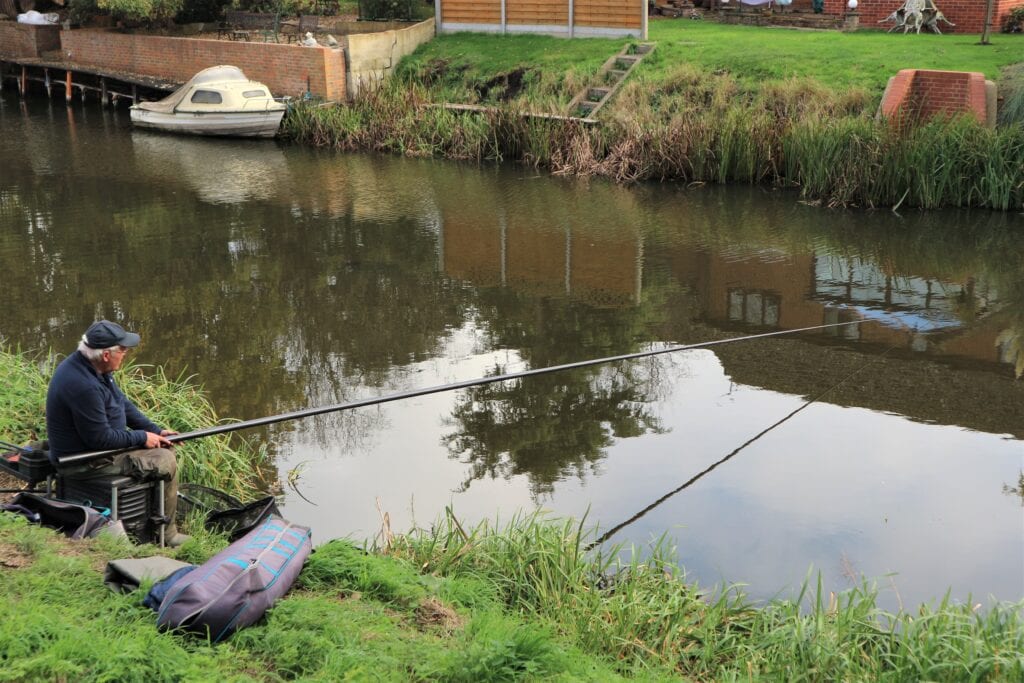
I was invited by a couple of Grantham pals to join them on a trip to the Old River Nene at Benwick, just outside Peterborough. It must be thirty years since I last visited this winter hotspot. The river course here is interlinked with many fenland drains, resulting in huge shoals of fish migrating into the sheltered areas the narrow old watercourse provides. When I arrived, my mates had picked a free fishing spot opposite some gardens and boat moorings, with plenty of tree cover behind to provide shelter from the cool fenland winds. The best pegs a bit further along were already taken. It soon turned out the slow-moving river was brimming with fish, although mainly on the small side. Baits like red maggots resulted in a bite nearly every cast from a great mixture of roach, perch, bleak, dace, hybrids, skimmers and silver bream. Casters turned up a few better-sized roach, while worm on the hook brought a bigger stamp of perch and a bonus winter tench for one of our party. With so many small fish to contend with, it was almost inevitable I would end up playing a pike, which grabbed a roach on the way in. The others had similar predator trouble a few times.
A CHRISTMAS BONUS
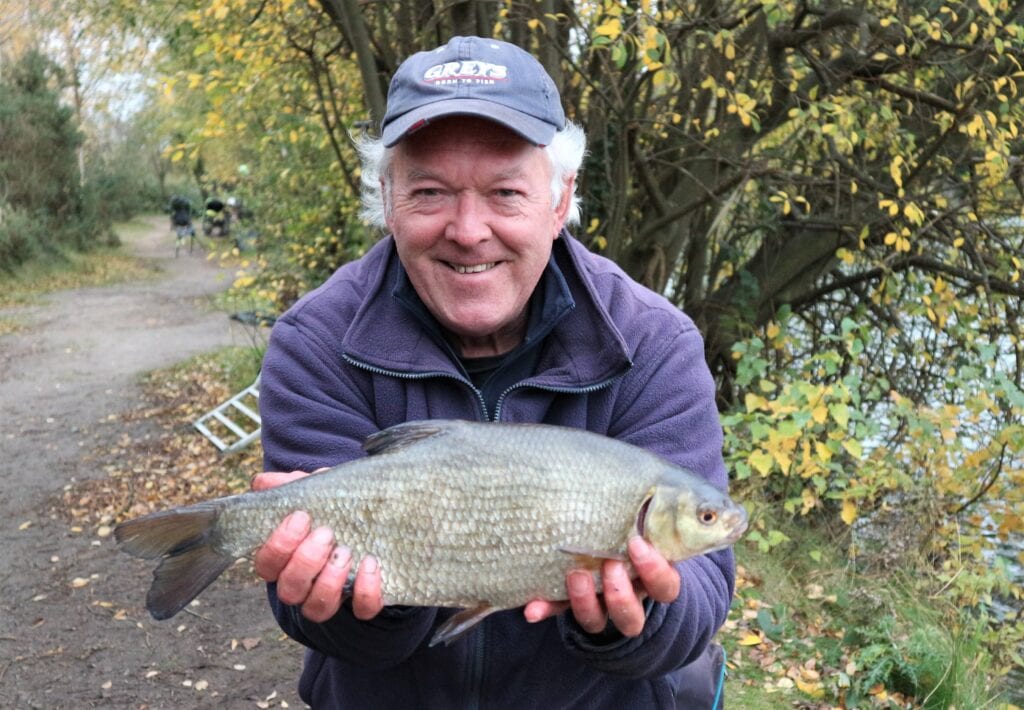
The Match Lake at Woodland Waters was the setting for my next club outing in the winter series. The lake had been fishing well but this picturesque place turned difficult with cold rainwater going in, combined with gale-force winds. Most anglers went straight onto feeder tactics, with the pole as backup in the few sheltered areas. Some small skimmers responded early, but as the fierce winds picked up it became a struggle. I only experienced a couple of iffy takes I didn’t connect with on the feeder. The only way I could make something happen was with a five-metre whip, fished to-hand style in the deep water. I caught a few small skimmers and roach, plus a bonus perch, but was struggling like the rest, made worse by the wind blasting in my face. I eventually hooked into a proper lump that bent my whip into a hoop. I felt the carbon bottoming out and feared my light rig would get trashed, but miraculously everything held and a superb 3lb hybrid boosted my catch into second place with 6lb 10oz. Tony Smith won with three bream and bits on the feeder for 8lb 9oz.
THE BOLT HOLE
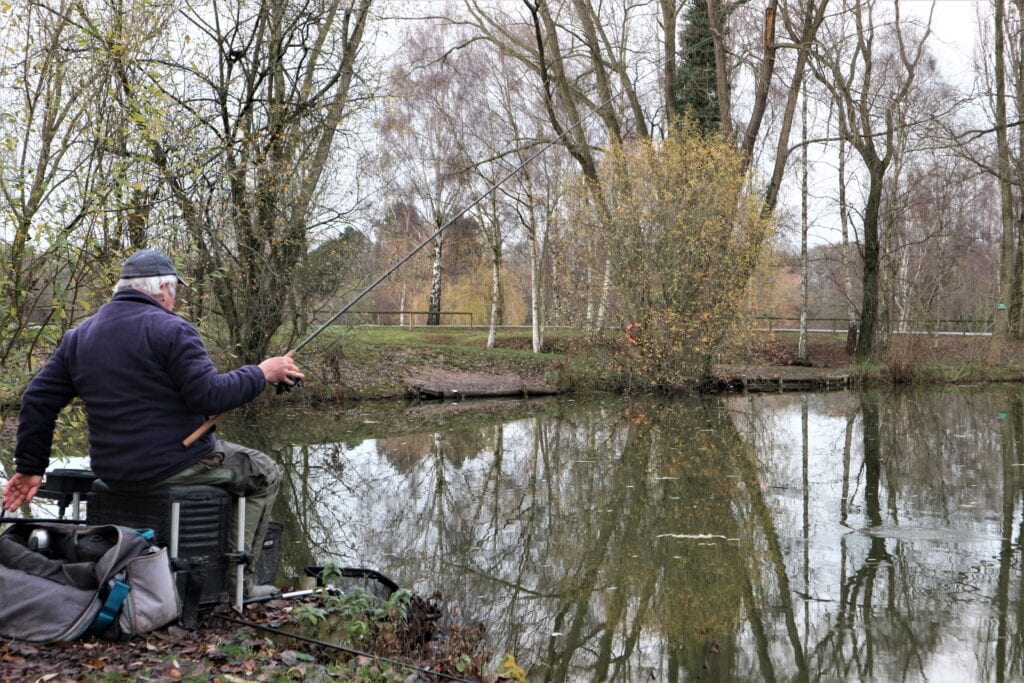
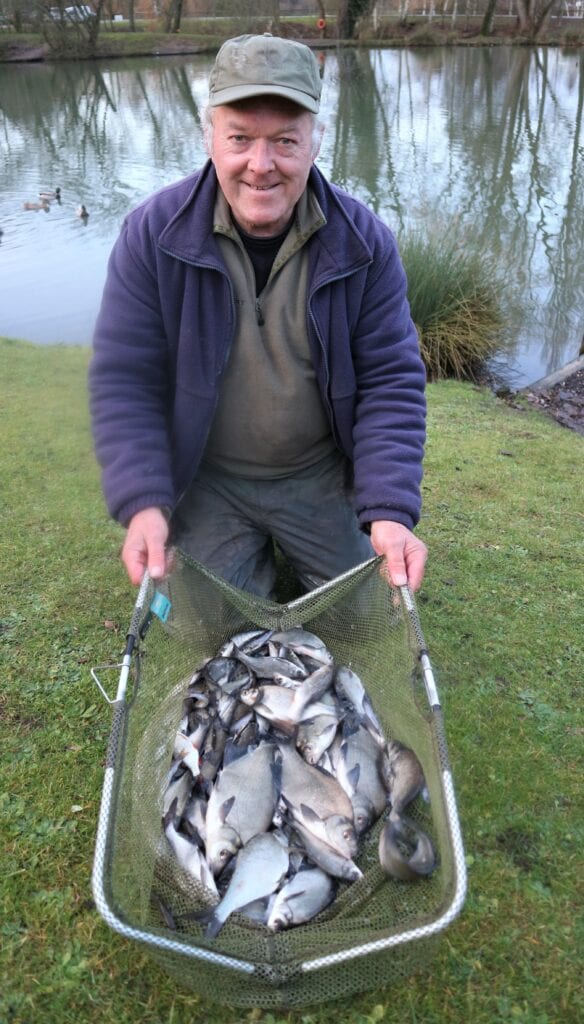
It turned bitterly cold and the winds were still strong, so where to next in order to catch some fish? I thought back to last winter and remembered the small Carp Lake at Woodies. The carp population slows down in the cold and there are masses of silver fish to target. They are not big, but provide plenty of bites when just about everywhere else has switched off. I set up a light 12ft waggler rod and a short 3m whip. The waggler tackle was aimed at anything that came along, while the whip was for a bit of fun with the numerous gudgeon the small, shallow water holds. I had an hour on the whip first, catching pongos as we used to call them. This reminded me of my canal match fishing days many years ago, where amazingly double-figure weights of these tiny fish used to be caught quite regularly. Feeding up the waggler line for the first hour did the trick, so when I switched to this method it was virtually a bite every cast for the rest of the session. A fair few net roach and skimmers, with lots of smaller fish, including perch, hybrids and rudd. I fed sweet-flavoured 2mm micro pellets like you would hemp, with a catapult, combined with casters and red maggots.
UNRAVELLING THE CANAL
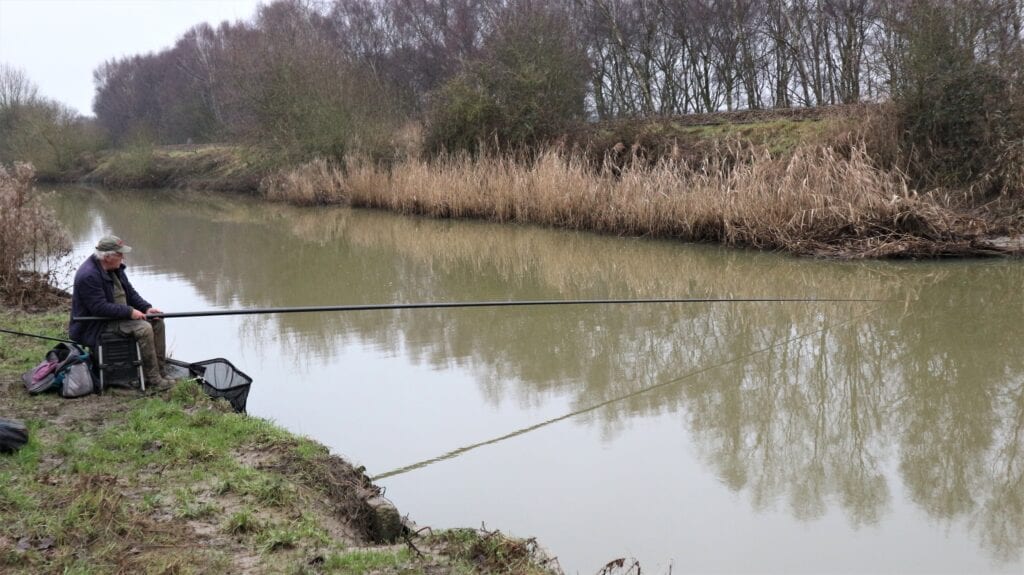
I only discovered the Fossdyke Canal this year and after enjoying some great fishing on it, decided to enter the Lincoln/Whisby Angling Supplies Individual League. I started well on the first match and then slumped dramatically on the next two rounds, getting blitzed by pike. This made me rethink my approach. For the penultimate match I planned to fish groundbait and pinkies at 5 metres on the pole, expecting that area to eventually attract any predator attention. I didn’t put groundbait anywhere else in my peg, instead cupping in some chopped worm just past the middle and then catapulting casters past this, over towards the far bank pilings. I started close in on the pole and caught 50 fish before the first signs of pike moving in slowed the bites down. A quick few casts with waggler tackle found some better roach on caster, but it wasn’t quite right over there yet. A quick flurry of fish followed back on the pole, before going back out with the waggler and finding it was solid. Mainly small 2-3oz roach, a few better-sized netters, plus a big perch. I finished with 10lb 9oz and a section win, coming third overall. 11lb 6oz won it, with 11lb 4oz second. Close!
TEASING A RESPONSE
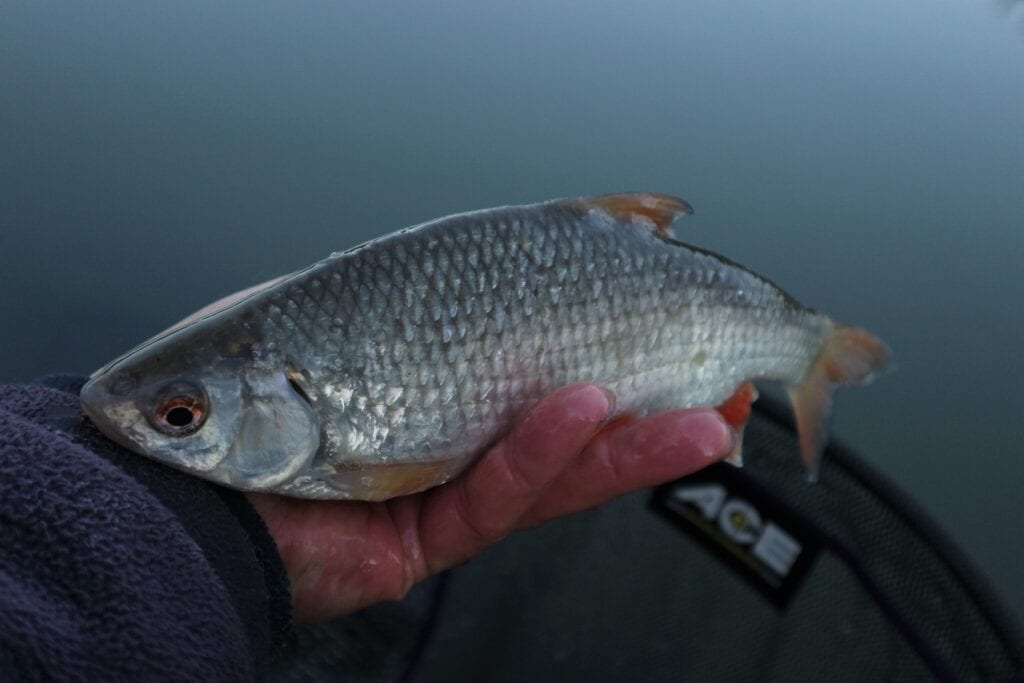
With the pandemic raging and the weather remaining windy and cold, I decided to stay close to home for the remainder of the year. I went back to try a swim on the Match Lake at Woodland Waters that I had struggled with previously, where the waggler brought me loads of bites, but very few fish. Most of these “ghost” indications as I call them are caused by roach, gently mouthing baits like maggots or casters, but then rejecting them. This is mainly a cold-water phenomenon, so I thought the long pole would be the best way of sorting it out. I intended to feed carefully, cupping in a few balls of dark groundbait laced with chopped worm and some red pinkies, feeding casters over the top by catapult. It took 30 minutes to get bites and the first two were rewarded with big roach, one just over the pound mark and one close to it. I wasn’t expecting that to happen straight away, because normally the bigger roach here don’t venture over groundbait until it has broken down into a fine bed on the bottom. This prompted me to cup in another medium-sized ball.
REPEAT PERFORMANCE
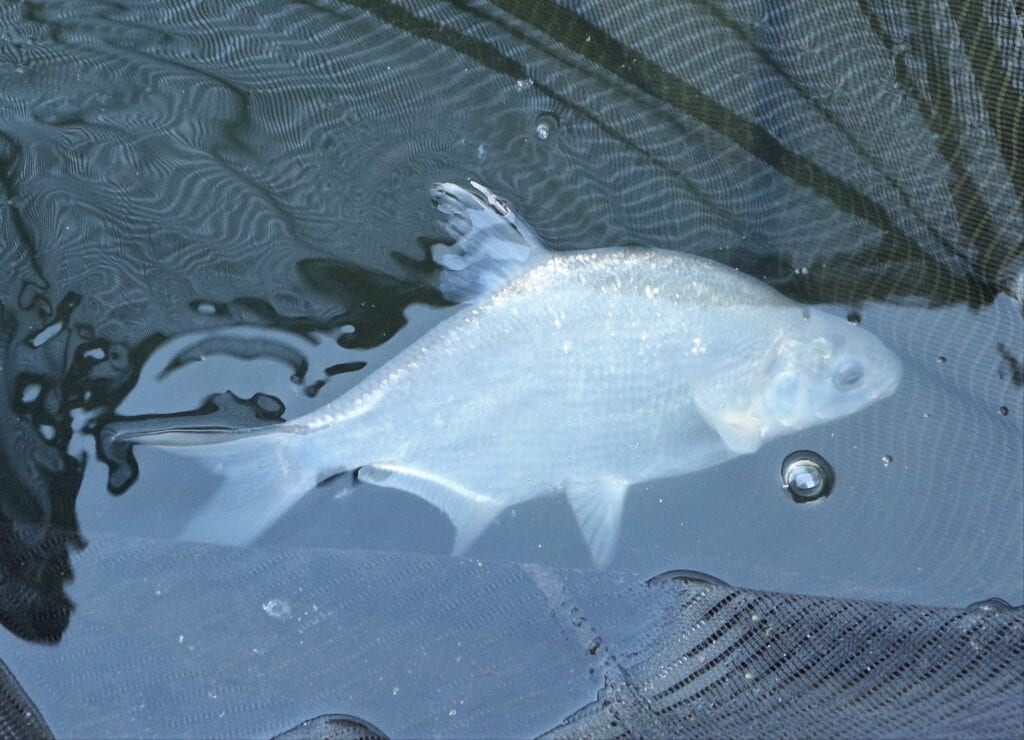
The new ball of groundbait, plus a bit more chopped worm and some red pinkies, stirred up another flurry of bites. This time it was slightly smaller roach before a decent skimmer went in my landing net. I kept dinking a few casters over my sensitive pole float.
Although this lake is quite deep, I use 0.75gr or 1gr body-down shaped floats with strung bulks of number 8 Stotz, instead of an olivette. I find the slightly strung main shotting, set a good three feet above the hook, helps the final three spread-out number 11 droppers below fall through the last layers of water nice and slowly. This often pulls an immediate bite as the hook bait settles, something that doesn’t happen so often with olivette rigs. I also use black nickel hooks, which don’t stand out as much as bronze or silver patterns. I find at this time of the year small tweaks like this make a big difference between enjoying lots of action, or sitting watching a motionless float all day.
WHICH WAY NEXT?
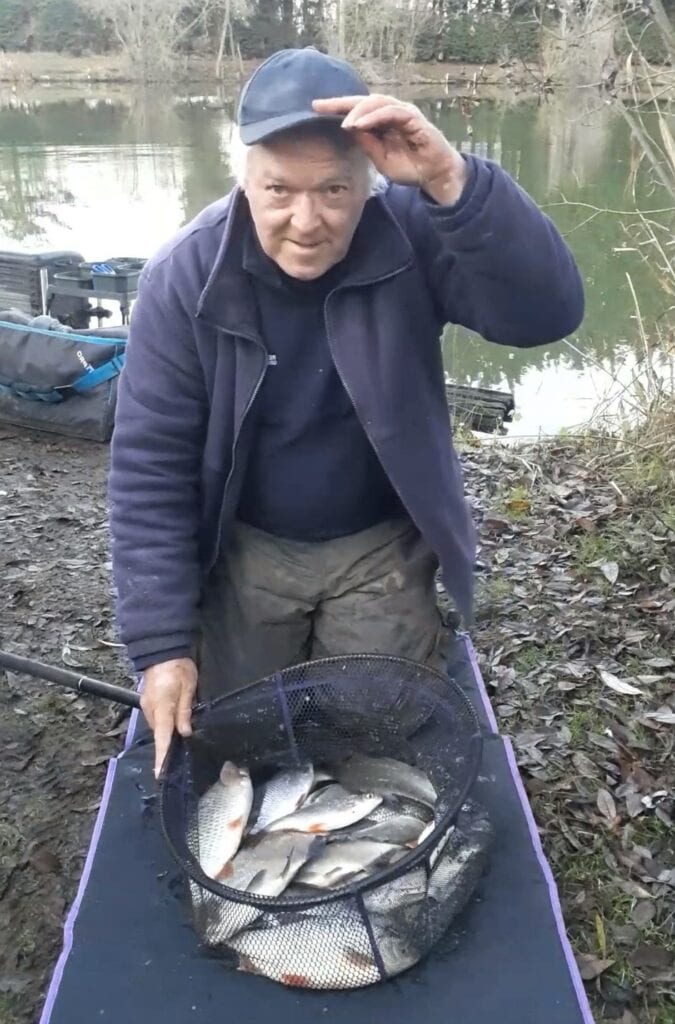
After that skimmer I was tempted to keep feeding regular balls of groundbait, but I have been down that route before. If you are not careful it’s easy to kill swims at this tricky time of the year after an initial good start. Cold-affected stillwaters need to be fed very sparingly, so I tried an experimental smaller ball of groundbait, but this time it didn’t work. It took ages to gain another response, dribbling in tiny amounts of casters every put in. Finally, the fish came back and I enjoyed a good end to the session, glad I had stopped feeding any crumb, because I think there was already enough in the swim. The trick at this time of the year is to interest but not over-feed the fish. I netted some more quality roach and several decent skimmers, to end up with a double-figure catch, on a day when I couldn’t see anyone else catching very much.
A CHANCE MEETING
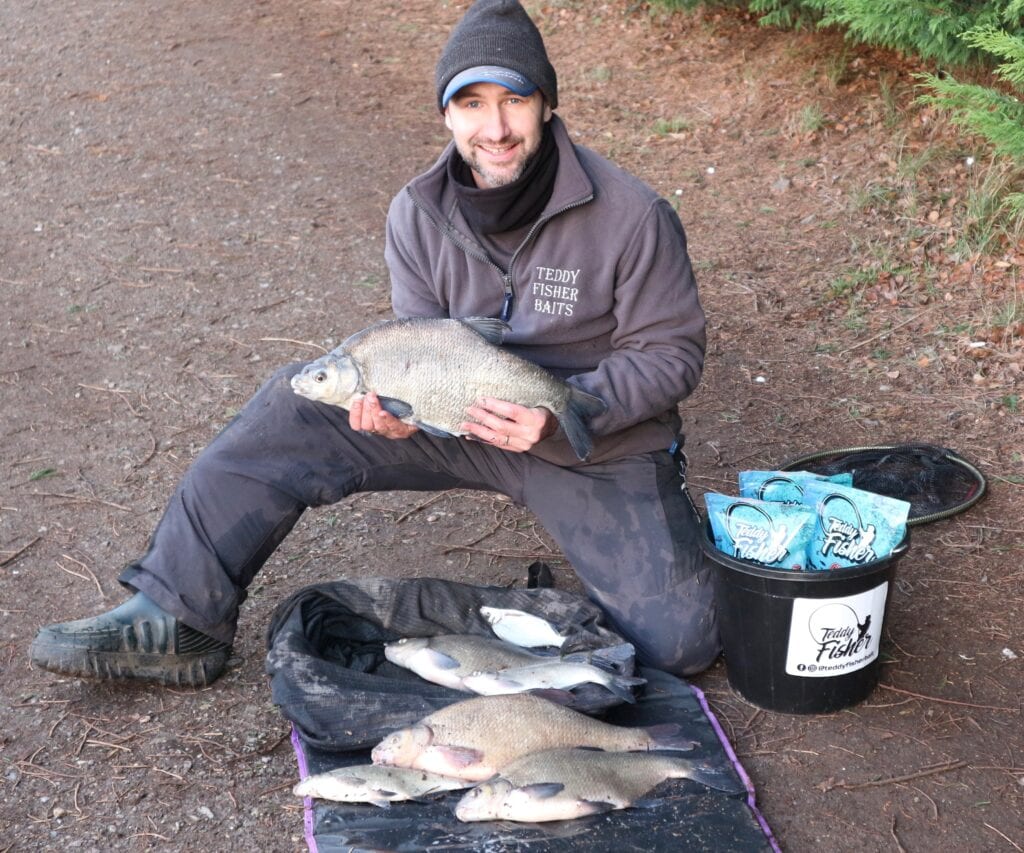
A few days later I returned to the Match Lake, but this time opted for the deeper water down the Eastern bank. There was one other angler already setting up and it turned out to be Dave Eastwood, who writes a similar angling column to my Grantham one, but in the neighbouring Sleaford local paper. Dave had only fished the complex once before, but watching him setting up a couple of pole rigs, he looked to be on the right track. It’s always nice to chat to like-minded anglers, swopping local venues to try. It turned out Dave has permission to fish a new fishery that’s opening soon, and he has invited me along in the New Year. Back to the present time and Dave did well on yet another bitingly cold day, eking out a nice catch of skimmers, topped off with a couple of bonus proper bream. He was using new groundbaits that are made in the Midlands, by a company called Teddy Fisher. They obviously work well! As for me, I caught a lot more smaller fish on this occasion, with only one decent roach and a few bigger skimmers.
The post Dave Coster’s Fishing Diary first appeared on FishingMagic Magazine.
Continue reading...
MISSING THE BUS
Spalding is only 40 minutes’ drive from where I live, and behind a big shopping centre called Springfields lies the Coronation Channel, which I’ve walked a few times while the wife enjoyed exploring the various discount outlets. On our latest trip I spotted a couple of anglers fishing with poles down by the tidal sluice. Fish were topping on the surface everywhere and the pair of locals were catching lots of skimmers and roach. I chatted with one of them and he told me the place used to be a popular match venue but was barely fished these days. He reckoned it can still produce top sport and that, apart from what he was catching, big bream and tench were a possibility as well. I returned a few days later with my mate Chris from Grantham. Conditions looked perfect but to cut a long story short, we couldn’t buy a bite between us. The water looked dead compared to what I had witnessed before, with two warring flocks of swans the only living things disturbing the surface. This prompted us to make a move to the nearby River Glen.
BACK ON TRACK

It soon became apparent where the fish had gone. The huge shoals of silvers that migrate into the smaller fens and rivers around Spalding during the colder months had obviously started moving early. The Glen at Pinchbeck was heaving. It’s only a narrow waterway, more a drain than a river, with steep dredged banks and little flow. But I’ve enjoyed some great sessions here during previous winters, particularly with the big perch, which run to specimen size. It quickly turned into a bite every put in fishing with pole tackle, mainly from small roach, skimmers and perch. A chilling wind was blowing hard downstream, which made it tricky to fish long. Chris and I mainly concentrated closer in, using maggots, casters and worms over groundbait. Towards the end of the short session, Chris caught some fair-sized perch, while when the wind dropped occasionally, he also found better roach dropping a rig close to the far bank. Other species that turned up were rudd, dace, bleak and small hybrids. A pike trashed a rig, but the monster perch didn’t show.
IN THE FLOW

The River Trent at Farndon is even closer to where I live, just twenty minutes down some back roads. The flow steadies off nicely downstream of the power station and weir, producing perfect conditions for a stick float, a form of fishing which is in danger of becoming a lost art. Many years ago, just about all anglers could be seen using sticks on the Trent, armed with several pints of maggots. But currently most people are targeting the big barbel, which entails having a couple of beefy specimen rods pointing skywards in support pods, very often with a pellet and boilie orientated attack.
It only took me 30 minutes to get bites, feeding a steady stream of hemp and casters, using a 4 number 4 capacity stick float and a size 18 hook tied to 2lb line. After that it turned into a hectic session, catching lots of pristine roach up to 8ozs and a few dace. Nothing big turned up, mainly because the river was running clear, but it was still great fun fishing this way, which keeps you active and warm during chilly winter days.
LAKE ACTION

A local angling club match was my next outing on Willow Lakes at Foston, just off the busy A1. The water was coloured after recent heavy rain and fished surprisingly well. Venue expert Alan Bilton drew the aerator peg on Hawthorne Lake, a noted bream hotspot. He continued his run of top form on this complex, finishing a clear winner with 73lb 7oz. To begin with, Alan fed maggots down the channel, catching a good stamp of skimmer bream. He then gradually worked his way across to an island, feeding further out and decent-sized carp began to boost his weight, along with more skimmers. I was a couple of pegs away and it took longer to get my swim producing, but after an hour good-sized skimmers turned up, along with odd carp. I couldn’t claw back the lead the eventual winner had built up, despite trying hard. I caught by switching between maggots and casters on pole tackle, cupping in a few micro pellets. I kept experimenting with various pellets on the hook, but strangely the fish didn’t want to know this bait, even soft expanders. A busy last hour boosted my catch to 49lb 14oz for runner’s-up spot, heading off a cluster of good backing weights.
THE OLD RIVER

I was invited by a couple of Grantham pals to join them on a trip to the Old River Nene at Benwick, just outside Peterborough. It must be thirty years since I last visited this winter hotspot. The river course here is interlinked with many fenland drains, resulting in huge shoals of fish migrating into the sheltered areas the narrow old watercourse provides. When I arrived, my mates had picked a free fishing spot opposite some gardens and boat moorings, with plenty of tree cover behind to provide shelter from the cool fenland winds. The best pegs a bit further along were already taken. It soon turned out the slow-moving river was brimming with fish, although mainly on the small side. Baits like red maggots resulted in a bite nearly every cast from a great mixture of roach, perch, bleak, dace, hybrids, skimmers and silver bream. Casters turned up a few better-sized roach, while worm on the hook brought a bigger stamp of perch and a bonus winter tench for one of our party. With so many small fish to contend with, it was almost inevitable I would end up playing a pike, which grabbed a roach on the way in. The others had similar predator trouble a few times.
A CHRISTMAS BONUS

The Match Lake at Woodland Waters was the setting for my next club outing in the winter series. The lake had been fishing well but this picturesque place turned difficult with cold rainwater going in, combined with gale-force winds. Most anglers went straight onto feeder tactics, with the pole as backup in the few sheltered areas. Some small skimmers responded early, but as the fierce winds picked up it became a struggle. I only experienced a couple of iffy takes I didn’t connect with on the feeder. The only way I could make something happen was with a five-metre whip, fished to-hand style in the deep water. I caught a few small skimmers and roach, plus a bonus perch, but was struggling like the rest, made worse by the wind blasting in my face. I eventually hooked into a proper lump that bent my whip into a hoop. I felt the carbon bottoming out and feared my light rig would get trashed, but miraculously everything held and a superb 3lb hybrid boosted my catch into second place with 6lb 10oz. Tony Smith won with three bream and bits on the feeder for 8lb 9oz.
THE BOLT HOLE


It turned bitterly cold and the winds were still strong, so where to next in order to catch some fish? I thought back to last winter and remembered the small Carp Lake at Woodies. The carp population slows down in the cold and there are masses of silver fish to target. They are not big, but provide plenty of bites when just about everywhere else has switched off. I set up a light 12ft waggler rod and a short 3m whip. The waggler tackle was aimed at anything that came along, while the whip was for a bit of fun with the numerous gudgeon the small, shallow water holds. I had an hour on the whip first, catching pongos as we used to call them. This reminded me of my canal match fishing days many years ago, where amazingly double-figure weights of these tiny fish used to be caught quite regularly. Feeding up the waggler line for the first hour did the trick, so when I switched to this method it was virtually a bite every cast for the rest of the session. A fair few net roach and skimmers, with lots of smaller fish, including perch, hybrids and rudd. I fed sweet-flavoured 2mm micro pellets like you would hemp, with a catapult, combined with casters and red maggots.
UNRAVELLING THE CANAL

I only discovered the Fossdyke Canal this year and after enjoying some great fishing on it, decided to enter the Lincoln/Whisby Angling Supplies Individual League. I started well on the first match and then slumped dramatically on the next two rounds, getting blitzed by pike. This made me rethink my approach. For the penultimate match I planned to fish groundbait and pinkies at 5 metres on the pole, expecting that area to eventually attract any predator attention. I didn’t put groundbait anywhere else in my peg, instead cupping in some chopped worm just past the middle and then catapulting casters past this, over towards the far bank pilings. I started close in on the pole and caught 50 fish before the first signs of pike moving in slowed the bites down. A quick few casts with waggler tackle found some better roach on caster, but it wasn’t quite right over there yet. A quick flurry of fish followed back on the pole, before going back out with the waggler and finding it was solid. Mainly small 2-3oz roach, a few better-sized netters, plus a big perch. I finished with 10lb 9oz and a section win, coming third overall. 11lb 6oz won it, with 11lb 4oz second. Close!
TEASING A RESPONSE

With the pandemic raging and the weather remaining windy and cold, I decided to stay close to home for the remainder of the year. I went back to try a swim on the Match Lake at Woodland Waters that I had struggled with previously, where the waggler brought me loads of bites, but very few fish. Most of these “ghost” indications as I call them are caused by roach, gently mouthing baits like maggots or casters, but then rejecting them. This is mainly a cold-water phenomenon, so I thought the long pole would be the best way of sorting it out. I intended to feed carefully, cupping in a few balls of dark groundbait laced with chopped worm and some red pinkies, feeding casters over the top by catapult. It took 30 minutes to get bites and the first two were rewarded with big roach, one just over the pound mark and one close to it. I wasn’t expecting that to happen straight away, because normally the bigger roach here don’t venture over groundbait until it has broken down into a fine bed on the bottom. This prompted me to cup in another medium-sized ball.
REPEAT PERFORMANCE

The new ball of groundbait, plus a bit more chopped worm and some red pinkies, stirred up another flurry of bites. This time it was slightly smaller roach before a decent skimmer went in my landing net. I kept dinking a few casters over my sensitive pole float.
Although this lake is quite deep, I use 0.75gr or 1gr body-down shaped floats with strung bulks of number 8 Stotz, instead of an olivette. I find the slightly strung main shotting, set a good three feet above the hook, helps the final three spread-out number 11 droppers below fall through the last layers of water nice and slowly. This often pulls an immediate bite as the hook bait settles, something that doesn’t happen so often with olivette rigs. I also use black nickel hooks, which don’t stand out as much as bronze or silver patterns. I find at this time of the year small tweaks like this make a big difference between enjoying lots of action, or sitting watching a motionless float all day.
WHICH WAY NEXT?

After that skimmer I was tempted to keep feeding regular balls of groundbait, but I have been down that route before. If you are not careful it’s easy to kill swims at this tricky time of the year after an initial good start. Cold-affected stillwaters need to be fed very sparingly, so I tried an experimental smaller ball of groundbait, but this time it didn’t work. It took ages to gain another response, dribbling in tiny amounts of casters every put in. Finally, the fish came back and I enjoyed a good end to the session, glad I had stopped feeding any crumb, because I think there was already enough in the swim. The trick at this time of the year is to interest but not over-feed the fish. I netted some more quality roach and several decent skimmers, to end up with a double-figure catch, on a day when I couldn’t see anyone else catching very much.
A CHANCE MEETING

A few days later I returned to the Match Lake, but this time opted for the deeper water down the Eastern bank. There was one other angler already setting up and it turned out to be Dave Eastwood, who writes a similar angling column to my Grantham one, but in the neighbouring Sleaford local paper. Dave had only fished the complex once before, but watching him setting up a couple of pole rigs, he looked to be on the right track. It’s always nice to chat to like-minded anglers, swopping local venues to try. It turned out Dave has permission to fish a new fishery that’s opening soon, and he has invited me along in the New Year. Back to the present time and Dave did well on yet another bitingly cold day, eking out a nice catch of skimmers, topped off with a couple of bonus proper bream. He was using new groundbaits that are made in the Midlands, by a company called Teddy Fisher. They obviously work well! As for me, I caught a lot more smaller fish on this occasion, with only one decent roach and a few bigger skimmers.
The post Dave Coster’s Fishing Diary first appeared on FishingMagic Magazine.
Continue reading...
Last edited by a moderator:

